



Part of the Are We All Addicts Now? exhibition at Furtherfield Gallery
Furtherfield co-director Ruth Catlow and artist Katriona Beales will be talking about the artwork featured in the exhibition at Furtherfield Gallery, Are We All Addicts Now?, followed by a group discussion.
In the exhibition, Katriona Beales addresses the sensual and tactile conditions of her life lived online: the saturated colour and meditative allure of glowing screens, the addictive potential of infinite scroll and notification streams. Her new body of work for Are We All Addicts Now? re-imagines the private spaces in which we play out our digital existence. Beales celebrates the sensuality and appeal of online spaces, but criticises how our interactions get channeled through platforms designed to be addictive – how corporations use various ‘gamification’ and ‘neuro-marketing’ techniques to keep the ‘user’ on-device, to drive endless circulation, and monetise our every click. She suggests that in succumbing to online behavioural norms we emerge as ‘perfect capitalist subjects’.
Join Ruth and Katriona to find out more about the works featured in the exhibition and to discuss the issues that it raises around digital addiction and online behaviour.
Katriona Beales is an artist who makes digital artefacts, moving image and installation, stressing the physicality of digital life. Are We All Addicts Now? develops Beales’ 2015 work ‘White Matter’ (a FACT commission for ‘Group Therapy: Mental Distress in a Digital Age’) which is showing at the University of New South Wales, Sydney as part of Anxiety Festival (Sept 2017). Beales’ received an MA from Chelsea College of Arts and has an artist profile on Rhizome.org
www.katrionabeales.com
Ruth Catlow is an artist and curator working with emancipatory network cultures, practices and poetics. She is co-founding director, with Marc Garrett, of Furtherfield. As new digital processes change the way we live, Furtherfield champions the need for society and culture to evolve critical, aesthetic and ethical responses in parallel, bringing together cultural and technological innovation. Recent commissions include Time Is Speeding Up (20-21 Visual Arts Centre); Sociality-machine (Tate); and Play the Web We Want (Southbank Centre). Catlow is named by the Foundation for P2P alternatives in their list of 100 women Co-creating the P2P society.
ruthcatlow.net
furtherfield.org
Furtherfield Gallery
McKenzie Pavilion
Finsbury Park, London, N4 2NQ
Visiting Information
While archaeology has often understood cultures through excavations of hoards and coins, what will today’s digital currencies tell future archaeologists about the way we live and trade?
This co-commission with NEoN Digital Arts Festival forms part of Furtherfield’s ongoing investigations into the politics of the blockchain, smart contracts, and cryptocurrency systems like Ethereum. It invites artists to imagine themselves as future media archaeologists, as recorders of our current information-based society, and as time-travelers highlighting the continued relevance of our long past. Will you dig for the digital, brush the dirt off the non-material, or excavate the internet?
In an era that threatens to be a digital dark age for future historians [1], blockchains may prove to be rare digital artefacts valuable enough to preserve into the future. There are already dozens of dead chains from abandoned cryptocurrencies [2], but with billions of dollars of value tied up in Bitcoin, Ethereum and other leading coins, the incentives to maintain their public ledgers are strong. Culture and knowledge have already been hidden in the blockchain – from images of Nelson Mandela to WikiLeaks cables [3] – but it is the blockchain as a record of our economic activity that concerns us here. This already has its history; on these public digital ledgers we can find everything from the ten thousand Bitcoins that were used to buy two pizzas [4] to the fifty million dollars of Ether that were stolen [5] in a hack on code running on the Ethereum blockchain. We just don’t have the best tools to visualise them yet.
We invite proposals for a new artistic online commission that takes the blockchain as the site of its manifestation. For example, artworks that are:
Whatever it is, it should work as a future media archeological artefact of blockchain finance and it has to be exhibitable online.
Hailed as both emancipatory opportunity for creative autonomy, and a driver of inequality and corporate opacity, the blockchain [10] is widely described as the Internet of Money. The blockchain is overtaking the WWW as the next big network technology for speculation and disruption. Investors recognise its potential in numerous ways: for high level authentication of identity [11] and matter [12]; for more efficient and secure financial transactions and distribution of digital assets; for communications so secure as to facilitate voting; and as a coordinating technology for the billions of devices connected to the Internet [13]
50 years ago this year, the world’s first ATM was designed, built and shipped from Dundee and installed in Enfield, less than 10 miles from Furtherfield. With this commission Furtherfield and NEoN recognise the role that the city of Dundee has played in the history of the development of smart technologies for financial transactions, through it being home to the R&D wing of The National Cash Register Corporation – NCR. [14]
NEoN Digital Arts Festival 2017 will expand on it being Scotland’s Year of History, Heritage and Archaeology, and seek to use its arts programme to unveil hidden histories through the practice of ‘media archaeology’. Media archaeologists uncover and reconsider the obsolete, persistent, and hidden material cultures of the technological age – from big data software algorithms to tiny silicon chips. With support from the National Lottery through Creative Scotland’s Open Project Fund, and Creative Europe Programme of the European Union, NEoN and Furtherfield invite artists to consider how the blockchain is the new ATM of the future.
The commission will be launched online and at NEoN Digital Arts Festival, and presented at the Digital Futures programme at V&A Museum and MoneyLab both in London in Spring 2018 as part of the European collaboration, State Machines which investigates the new relationships between states, citizens and the stateless made possible by emerging technologies.
Open Call announced 11th August
Deadline 4th September
6-9 September – follow up conversations where necessary (by email/phone)
13th September – decision made, artists informed and announced
19th September – public debate about cryptocurrencies in Dundee (organised by Scotcoin https://www.meetup.com/scotland-and-digital-currency/events/242087813/)
9th October – selected artist give progress report
9th November – Work installed for opening of NEoN Festival, Dundee. Artist presents work
Spring 2018 – Work re-presented with MoneyLab and V&A Digital Futures
(Note an additional £500 is available for accommodation and expenses for attendance at events in Dundee and London)
Submissions must include a proposal:
Documents should be submitted as PDFs or as links to a Google Doc, a GitHub Repo, or another easily read and easily accessed format.
If you have questions or enquiries about this commission please email alison.furtherfield[AT]Gmail.com
Notice of submissions via the Bitcoin blockchain should be sent via an OP_RETURN message starting with the word FField followed by a single space and the url of the proposal. E.g.:
FField https://docs.google.com/document/d/2oGsmli7Mlm-M_CZkL8WTKM3oUU3a
OP_RETURN messages can be created using the Crypto Grafitti service:
http://www.cryptograffiti.info/
Notice of submissions via Keybase messaging, or submissions of documents via KeybaseFS should be sent to:
(Note: Keybase does require registration but is free to join.)
Notice of submissions, or submissions of documents via email can be sent to ruth.catlow[AT]furtherfield.org
Please use the subject line “Furtherfield NEoN Proposal”.
Furtherfield
Through artworks, labs and debate around arts and technology, people from all walks of life explore today’s important questions. The urban green space of London’s Finsbury Park, where Furtherfield’s Gallery and Lab are located, is now a platform for fieldwork in human and machine imagination – addressing the value of public realm in our fast-changing, globally connected and uniquely superdiverse context. An international network of associates use artistic methods to interrogate emerging technologies to extend access and grasp their wider potential. In this way new cultural, social and economic value is developed in partnership with arts, research, business and public sectors.
NEoN
NEoN (North East of North) based in Dundee, Scotland aims to advance the understanding and accessibility of digital and technology driven art forms and to encourage high quality within the production of this medium. NEoN has organised 7 annual festivals to date including exhibitions, workshops, talks, conferences, live performances and public discussions. It is a platform to showcase national and international digital art forms. By bringing together emerging talent and well-established artists, NEoN aims to influence and reshape the genre. We are committed to helping our fabulous city of Dundee, well known for its digital culture and innovation, to become better connected through experiencing great art, networking and celebrating what our wee corner of Scotland has to offer in the field of digital arts.
State Machines: Art, Work and Identity in an Age of Planetary-Scale Computation
Focusing on how such technologies impact identity and citizenship, digital labour and finance, the project joins five experienced partners Aksioma (SI), Drugo More (HR), Furtherfield (UK),Institute of Network Cultures (NL) and NeMe (CY) together with a range of artists, curators, theorists and audiences. State Machines insists on the need for new forms of expression and new artistic practices to address the most urgent questions of our time, and seeks to educate and empower the digital subjects of today to become active, engaged, and effective digital citizens of tomorrow.
V&A Digital Futures: Digital Futures
V&A Digital Futures: Digital Futures is a monthly meetup and open platform for displaying and discussing of work by professionals working with art, technology, design, science and beyond. It is also a networking event, bringing together people from different backgrounds and disciplines with a view to generating future collaborations.
Creative Scotland
Creative Scotland is the public body that supports the arts, screen and creative industries across all parts of Scotland on behalf of everyone who lives, works or visits here. It enables people and organisations to work in and experience the arts, screen and creative industries in Scotland by helping others to develop great ideas and bring them to life. It distributes funding from the Scottish Government and The National Lottery.
This project has been funded with the support from the European Commission. This communication reflects the views only of the author, and the Commission cannot be held responsible for any use which may be made of the information contained therein.
DOWNLOAD PRESS RELEASE
Book launch, drinks reception, and discussion.
Max Dovey “Love on the Block”: using blockchain for wedding vows
plus JJ Charlesworth in conversation with editors
Artists Re:Thinking the Blockchain is the first book of its kind, intersecting artistic, speculative, conceptual and technical engagements with the the technology heralded as “the new internet”. The book features a range of newly commissioned essays, fictions, illustration and art documentation exploring what the blockchain should and could mean for our collective futures.
This event features talks and conversation by contributors and editors of the publication, and an opportunity to be among the first to purchase the unique print edition.
Artists Re:Thinking The Blockchain
Imagined as a future-artefact of a time before the blockchain changed the world, and a protocol by which a community of thinkers can transform what that future might be, Artists Re:Thinking The Blockchain acts as a gathering and focusing of contemporary ideas surrounding this still largely mythical technology. The full colour printed first edition includes DOCUMENTATION of artistic projects engaged in the blockchain, including key works Plantoid, Terra0 and Bittercoin, THEORISATION of key areas in the global blockchain conversation by writers such as Hito Steyerl, Rachel O’Dwyer, Rhea Myers, Ben Vickers and Holly Herndon, and NEW POETRY, ILLUSTRATION and SPECULATIVE FICTION by Theodorios Chiotis, Cecilia Wee, Juhee Hahm and many more. It is edited by Ruth Catlow, Marc Garrett, Nathan Jones and Sam Skinner.
Along with a print edition, Artists Re:Thinking the Blockchain includes a web-based project in partnership with Design Informatics at University of Edinburgh: Finbook is an interface where readers and bots can trade on the value of chapters included in the book. As such it imagines a new regime for cultural value under blockchain conditions.
This book and surrounding events is produced in collaboration between Torque and Furtherfield, connecting Furtherfield’s Art Data Money project with Torque’s experimental publishing programme. It is supported by an Arts Council England Grants for the Arts, Foundation for Art and Creative Technology and through the State Machines project by the Creative Europe Programme of the European Union.
Available from Liverpool University Press, order copies here
CONTACT
Nathan Jones and Sam Skinner
mail@torquetorque.net
07877660150
Social media
@furtherfield
Artists Re:Thinking The Blockchain
ed. Ruth Catlow, Marc Garrett, Sam Skinner and Nathan Jones
published by Torque and Furtherfield
in partnership with Foundation for Art and Creative Technology (FACT)
ISBN: 978-0-9932487-5-7
distributed by Liverpool University Press
contact for stockist enquiries: lup@liv.ac.uk
Foreword by Sam Skinner and Nathan Jones
Introduction by Ruth Catlow
A: documents
FinBook: Literary content as digital commodity – Rory Gianni⍏, Hadi Merpouya*, Dave Murray-Rust⍏, Bettina Nissen⍏, Shaune Oosthuizen⍏, Chris Speed⍏, Kate Symons**
Text as Market – Ami Clarke
Plantoid – Primavera De Filippi
Terra0 – Paul Seidler, Paul Kolling, and Max Hampshire
Critical mining: blockchain and bitcoin in contemporary art by Martín Nadal & César Escudero Andaluz
The Blockchain: Change everything forever by Peter Gomes
Satoshi Oath by Jaya Klara Brekke and Elias Haase
01.01.20 by Kimberley ter Heerdt & Nikki Loef
Role Play Your Way to Budgetary Blockchain Bliss by Pablo Velasco
A Shared Timeline – PWR Studio
Blockchain Future States – Simon Denny (and artist interview)
B: fictions
Flying Under A Neutral Flag – Cecilia Wee
History of Political Operating Systems > Interview with Dr. L. Godord b – Elli Kuruş
All That Happened – Surfatial
Bad Shibe – Rhea Myers and Lina Theodorou
Defixio Nervorum – Theodoros Chiotis
How to Surf – Juhee Hahm
C: theories
If You Don’t Have Bread, Eat Art!: Contemporary Art and Derivative Fascisms – Hito Steyerl
immutabilty mantra – Ben Vickers
Blockchain Poetics – Rhea Myers
Love on the Block by Max Dovey
Collections management on the blockchain: A return to the principles of the museum – Helen Kaplinsky
Artists Rights in the Era of the Distributed Ledger – Mark Waugh
Everything You’ve Always Wanted to Know About the Blockchain* (*But Were Afraid to Ask Mel Ramsden) – Martin Zeilinger
Does digital culture want to be free? How blockchains are transforming the economy of cultural goods – Rachel O’Dwyer
Aphantasia – blockchain as medium for art – Bjørn Magnhildøen, Noemata
Interview with Holly Herndon and Mat Dryhurst – Marc Garrett
Carla Gannis and Alan Sondheim will be talking about their artwork featured in the new exhibition at Furtherfield Gallery, Children of Prometheus.
In the exhibition Carla Gannis updates Hieronymus Bosch’s famous triptych in her Garden of Emoji Delights replacing medieval religious symbolism with an emotion-inspired iconography for the 21st century. Bosch’s painting was made between 1490 and 1510. In the original, the left panel depicts God presenting Eve to Adam, the central panel is a broad panorama of socially engaged nude figures, fantastical animals, oversized fruit and hybrid stone formations. The right panel is a hellscape and portrays the torments of damnation. Gannis’s contemporary version plays on the original themes, and even expresses hedonism. However, there is another message looming in the work. That, even though we are entwined today in our digital networks, products of hyper-capitalism, and technological devices, learned culture, and acquired values: we are all feral beings at our core.
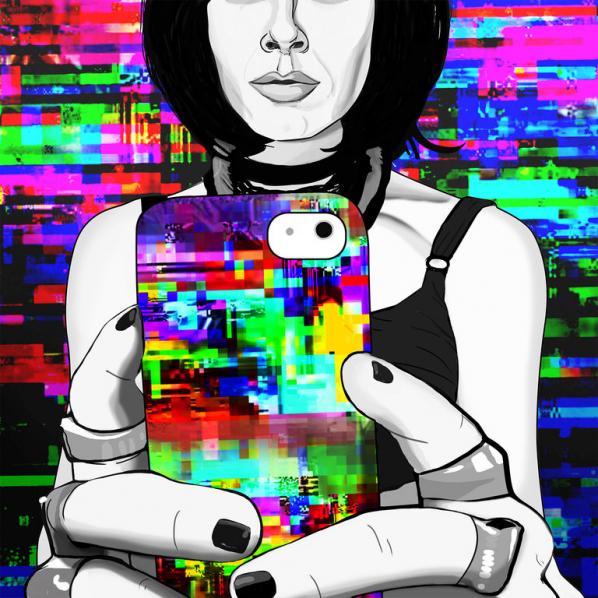
In the exhibition, Alan Sondheim presents Avataurror, a series of 3D printed avatars and videos representing distorted, wounded, problematic bodies, and their relationship to states of violence and genocide, where cracks and wounds are eternally everywhere and nowhere. Most of what Alan does, is grounded in philosophy – ranging from phenomenology to current philosophy of mathematics to his own writing. “I’m interested in the ‘alien’ which isn’t such of course, which is blankspace. (The alien is always defined within edge spaces and projections; we project into the unknown and return with a name and our fears and desires.)”
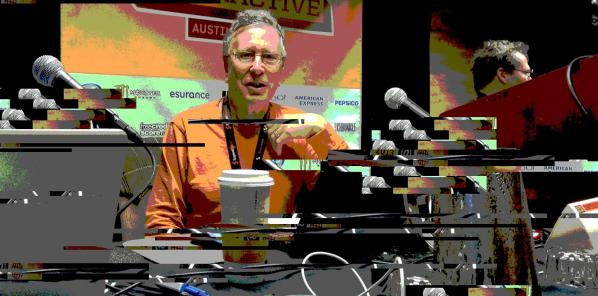
Carla Gannis is an artist who lives and works in Brooklyn, New York. She received a BFA in painting from The University of North Carolina at Greensboro and an MFA in painting from Boston University. In the late 1990s she began incorporating net and digital technologies into her work. Gannis is the recipient of several awards, including a 2005 New York Foundation for the Arts (NYFA) Grant in Computer Arts, an Emerge 7 Fellowship from the Aljira Art Center, and a Chashama AREA Visual Arts Studio Award in New York, NY. She has exhibited in solo and group exhibitions both nationally and internationally. She is currently Assistant Chair of Digital Arts at Pratt Institute in Brooklyn.
Alan Sondheim was born in Wilkes-Barre, Pennsylvania; he lives with his partner, Azure Carter in Brooklyn NY. A cross-disciplinary artist, writer, and theorist, he has exhibited, performed and lectured widely. Recently, Sondheim had a successful residency at Eyebeam Art + Technology Center in New York; while there he worked with a number of collaborators on performances and sound pieces dealing with pain and annihilation. He also created a series of texts and 3D printing models of ‘dead or wounded avatars.’ His ideas explore death, sex, space, time, terror and how these effect our psyche and the body.
More information about Children of Prometheus.
FREE
BOOKING IS ESSENTIAL – BOOK HERE
STRICTLY NO LATE ADMITTANCE
DOWNLOAD PRESS RELEASE
DOWNLOAD EXHIBITION CATALOGUE
Featuring Anna Dumitriu (in collaboration with Melissa Grant and Rachel Sammons), Carla Gannis, AOS (Art is Open Source), Simon McLennan, and Alan Sondheim.
Humans have always exploited the raw materials this planet has to offer – with the power to change the nature of things, whether physical or virtual. With constant re-edits and enhancements we transform everything we touch as part of our evolutionary mutation. In Greek mythology Prometheus was a demigod and a Titan worshipped by craftsmen. Greek Titans were ultimately honoured as the ancestors of humans, who in turn were attributed with “the invention of the arts and magic” (Graves 1964). The artists featured in Children of Prometheus at Furtherfield Gallery explore the possible consequences of our scientific and technological imaginings for us as individuals, our society and the world at large.
In this exhibition, visitors can encounter Anna Dumitriu’s Microbe Mouth, a necklace of unique teeth grown from bacteria. Microbe Mouth is a collaboration with scientists Melissa Grant and Rachel Sammons from the University of Birmingham’s School of Dentistry. Carla Gannis updates Hieronymus Bosch’s famous triptych in her Garden of Emoji Delights replacing medieval religious symbolism with an emotion-inspired iconography of the 21st century. Alan Sondheim’s Avataurror are 3D printed avatars representing distorted, wounded, problematic bodies and their relationship to states of violence and genocide, where cracks and wounds are eternally everywhere and nowhere. Simon McLennan’sDrawings reflect intimate contradictions in our dysfunctional society showing us daily mutations. When the artist and open-source engineer Salvatore Iaconesi, one of the artist duo AOS (Art is Open Source), was diagnosed with cancer he launched a participatory open source initiative to find a cure. The resulting global art performance La Cura explores the complexity of being human and seeks to find ways to reclaim our bodies in collaboration with others. The exhibition considers the roles of our arts and science traditions, and how they are played out while examining: governance, posthumanism, biohacking, and biopolitics.
This exhibition is produced in partnership with LABoral, in Gijon, as an extension of the Monsters of the Machine exhibition 18 Nov 2016 – 21 May 2017. Based on Mary Shelley’s classic novel Frankensteinwritten 200 years ago which continues to offer a lens through which to examine current practices in arts and technology and how they shape society today.
Anna Dumitriu – Microbe Mouth
Carla Gannis – Garden of Emoji Delights
Simon McLennan – Drawings
Alan Sondheim – 3D Printed glitch avatars & Landscape tablets, 2 Glitch videos
AOS (Art is Open Source) Salvatore Iaconesi & Oriana Persico – La Cura
Alan Sondheim – Presentation
Wednesday 5 July 2017, 6.30 – 8.30pm
Furtherfield Commons, Finsbury Park
FREE
Artist Talks: Carla Gannis and Alan Sondheim
Monday 10 July 2017, 6:30 – 8.30pm
CAS, Davidson House, 5 Southampton Street, London WC2E 7HA
FREE – booking essential, strictly no late admittance (register)
[1] Robert Graves. Larousse Encyclopedia of Mythology. Paul Hamlyn, London. 5th Edition, 1964. P.92.
[2] Body Drift: Butler, Hayles, Haraway (Posthumanities). Author Arthur Kroker. University of Minnesota Press (22 Oct. 2012).
[3] Body Drift: Butler, Hayles and Haraway. Review by Marc Garrett 15/08/2015.
The exhibition draws upon ideas originally written in an essay Prometheus 2.0: Frankenstein Conquers the World! Marc Garrett.
Part of the NEW WORLD ORDER exhibition at Furtherfield Gallery
BOOKING ESSENTIAL – Limited places available for this FREE workshop
A day of design-based research using the GeoCoin platform to explore novel ways of reconsidering and reinventing currency through location-specific value transactions. How can money be reprogrammed to interact with or react to everyday practices of value exchange in and around the city? Explore these and more questions with the Design Informatics team from the University of Edinburgh.
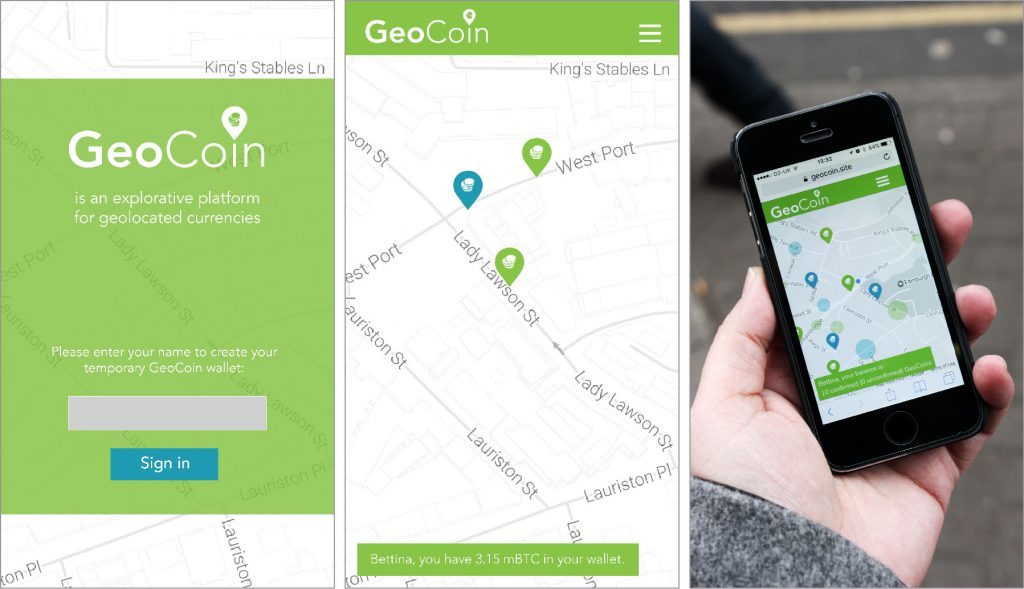
This workshop is part of the ESRC funded research project After Money lead by Design Informatics at the University of Edinburgh.
Saturday 24 June, 11-1pm and 2-4pm, Furtherfield Gallery
Ever wanted to join your partner in bitcoin matrimony? Or wanted to join another partnership for a short time only? You’ve come to the right place. For this day only, you can record your short-term bitcoin union via Handfastr on the blockchain in an immutable and ever growing ledger of bitcoin marriages at the Furtherfield Gallery.

This project is part of the ESRC funded research project After Money lead by Design Informatics at the University of Edinburgh.
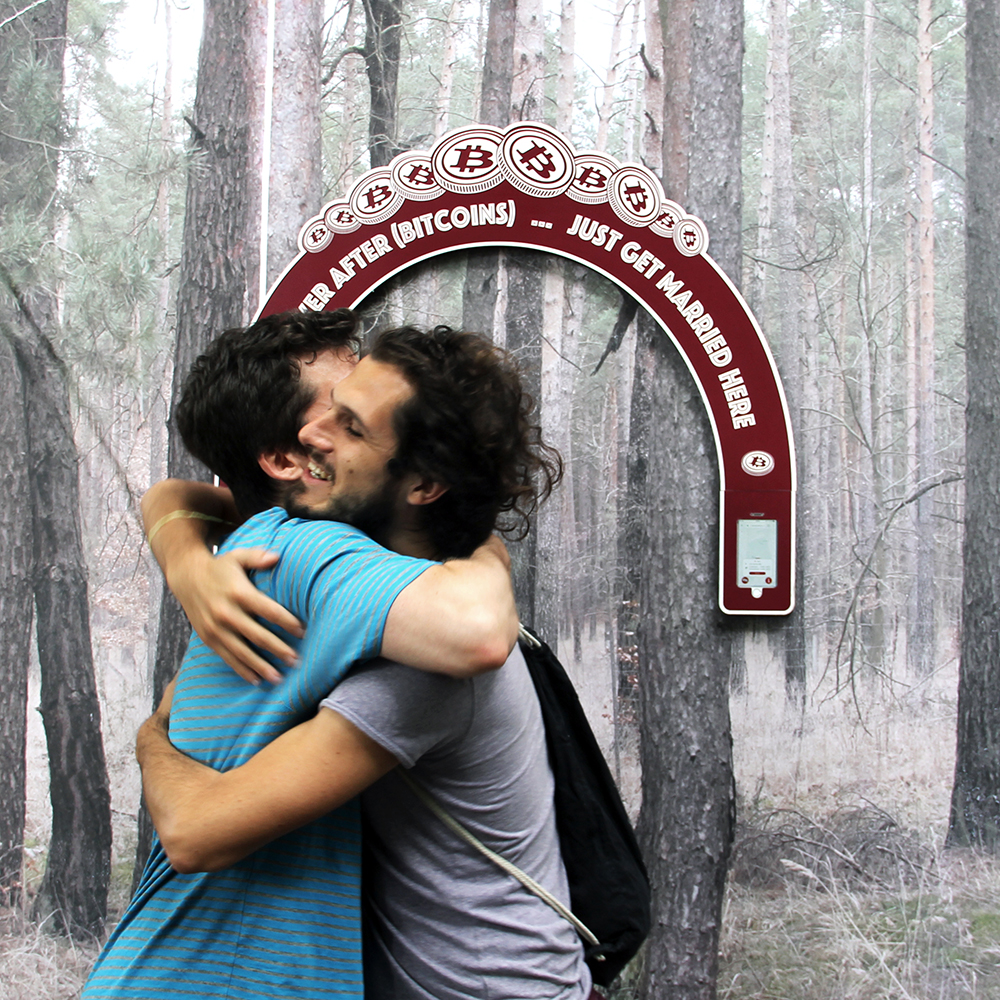
Part of the NEW WORLD ORDER exhibition at Furtherfield Gallery
BOOKING ESSENTIAL – Limited places available for this FREE workshop
In partnership with Antiuniversity Now 2017
As demonstrated by the works in the NEW WORLD ORDER exhibition at Furtherfield Gallery, blockchain technologies and cultures display a remarkable capacity to embody the interests of diametrically opposed political ideologies. Manpowertop looks more widely at the subject of Silicon Valley companies and how their promotional media envisions “the future” of their technology’s role in society.
The recent publication of Mark Zuckerberg’s open letter, titled Building Global Community, has drawn debates about the accelerationist politics of Silicon Valley into the public sphere once again. The seductive message of the manifesto itself is unsurprising, and is typical of the glossy promotional media released by other tech companies: We are told that new technologies can facilitate greater social inclusion, foster democratic grassroots political movements, and allow us to be more productive in our labour and leisure. While such media are often renderings of some notional “future” existence, what might they reveal about the ways we delimit our understanding of the present? Additionally, what would have to happen between “now” and “then” for these visions to be fully realised?
Manpowertop is a workshop that takes these questions as a starting point, challenging participants to diagnose the power relations in these branded visions of the future. Participants will adopt “troubleshooting” as a critical framework for enquiry, and produce diagrammatic readings of these speculative technologies, the networks they interlink with, and their associated politics of usership. In doing so, we will collectively identify what is left out of these visions, and explore how these omissions might offer an insight into the power relations that exist between users and technological platforms in the present.
Network Diagnostics is the collaborative research practice of Niall Docherty and Dave Young, focused on using technical models of “troubleshooting” as a mode of critically engaging with digital culture.
Niall Docherty is a PhD candidate at the Centre for Critical Theory at Nottingham University. His project attempts to combine the empirical foundations of software studies and Foucauldian governmentality to analyse Facebook within the neoliberal context of its inception and current use. He has completed two degrees at Goldsmiths – a BA in Politics in 2014, and an MA in Cultural Studies the following year. Niall was born and currently lives in Sheffield, ‘the greenest city in Europe’ according to some sources.
Dave Young is also a PhD candidate at the Centre for Critical Theory at Nottingham University, and is currently researching bureaucratic media and systems of command and control in the US military since the Second World War. His practice takes the form of workshops, talks, texts, and website development, and he has presented work for organisations such as the Disruption Network Lab, Transmediale, Servus, and Furtherfield. An archive of past/ongoing work can be found at dvyng.com.
BOOKING ESSENTIAL – Limited places available for this FREE workshop
BOOK HERE
Furtherfield Commons
Finsbury Park, London, N4 2NQ
Visiting Information
Furtherfield Gallery is supported by Haringey Council and Arts Council England
DOWNLOAD PRESS RELEASE (.pdf)
For her exhibition at Furtherfield Gallery, Alison Ballard presents Offline Is The New Luxury a collection of works exploring our relationship with technology and the Internet. When daily encounters are increasingly mediated by online technology, how is this affecting our experience of live-ness, presence, and time?
With live streaming, instant replays and video chat technologies, concepts of time, space, and distance, are changing. We ‘hang out’ together online, we ‘live chat’ with computer algorithms, watch cat videos over and over again and share world political events as they happen, ‘in real time’. Contemporary Western culture has become now-centric. Social media offers more ways than ever to ‘go live’ meaning we no longer have to share our experiences with others in the past tense (a photograph we took on holiday or a video of the event we attended last week). Instead, we share our every moment instantaneously in a continuously unfolding now.
The Narrator Is Present is an audio work with narrative ambiguity and a sinister underbelly. How can we distinguish fictional narrative from truth among the multitude of disembodied voices on the Internet? Who is it that is speaking to us and what do they want? Existing simultaneously in Furtherfield Gallery and online, the work also explores the dualistic experiences of the virtual and the physical, and the ways in which these two spaces contribute to a single reality.
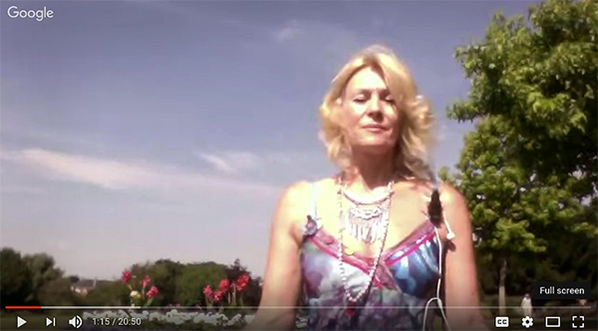
In Live Stream of Consciousness Ballard asks; can the Internet be good for our health? Spending time in parks can improve mental and physical wellbeing by relieving stress, reducing depression, improving memory and cognitive function, and boosting creativity. Can the same mental and physical health benefits of visiting a park be achieved via meditation, online? Ballard attempts to find out with this 20-minute seated meditation, originally broadcast as a live stream from Chalkwell Park, Southend-on-Sea, in 2016. By displaying this work inside Furtherfield Gallery, the artist invites us to reflect upon the physical and mental health benefits that Finsbury Park brings to our day-to-day lives.
Through these works and more, Ballard reflects upon the current state of hyper-reality; the context-collapse of the real and unreal, the distinction between what is simulated and what seems ‘real’, and invites us to reconsider our view of reality.
Online Live Stream of The Narrator Is Present
Available online during gallery opening times, from 6 April
http://bit.ly/2mExQ0v
The Narrator Is Present exists live; in the gallery, and online. Visit Furtherfield Gallery to be physically complicit in the work or watch online to be a distanced voyeur.
Online Exhibition Walkthrough with Ruth Catlow Co-Founder and Co-Director of Furtherfield
Available from 7 April 2017 on Alison Ballard’s YouTube Channel, in 2D video and Google Cardboard via the YouTube App.
http://bit.ly/2mExQ0v
Also available to view in the Gallery. Please ask a member of staff
Everyday Fiction / NetPark
Open Day 11:00 – 16:00, Saturday 15 April 2017
Metal, Chalkwell Hall, Chalkwell Park, Southend-on-Sea, Essex, SS0 8NB
A chance to experience Alison Ballard’s geo-locative audio work Everyday Fiction; a heart-breaking story of loss, grief, and mental illness that explores the ambiguity between reality and fiction that we encounter in everyday life. Site-Specific to Chalkwell Park, it forges a relationship between the audio, the location, and your presence within it. A moving experience with content that some listeners may find challenging.
Just one of the many app-based experiences on offer as part of NetPark; a collection of site-specific digital artworks commissioned by Metal. Find out more on the NetPark website: http://www.netpark.zone/artist-projects
If you have a smart phone, we recommend downloading the App before your visit and connecting to the free NetPark WiFi upon your arrival, to improve your GPS signal.
Download for Apple iOS: http://apple.co/2moPeWA
Download for Android: http://bit.ly/2mEFuI
Don’t have a smart phone? That’s OK, you can borrow an iPad from Metal on the day, free of charge.
Alison Ballard explores the ambiguity between fiction and reality, the real and unreal, and the known and the imagined, through temporal works of film, installation, audio, performance, and geo-locative technologies.
Derived from everyday experiences and observations, coupled with an interest in the dislocated relationship of image and sound, and phenomenology, she seeks to produce cross-disciplinary artworks that question our relationships with people, places, and objects, and the shifting meanings of time, presence, and liveness.
Alongside her practice, Alison is Associate Lecturer at Nottingham Trent University and a freelance producer in London and Nottingham. More information can be found on her website: http://alisonballard.com/
Furtherfield was founded in 1997 by artists Marc Garrett and Ruth Catlow. Since then Furtherfield has created online and physical spaces and places for people to come together to address critical questions of art and technology on their own terms.
Furtherfield Gallery
McKenzie Pavilion
Finsbury Park, London, N4 2NQ
Visiting Information
After five years hard work by its volunteers and incredible public support, The Green Backyard, a community growing project in Peterborough run entirely by volunteers, is no longer threatened with redevelopment: the owners of the land, Peterborough City Council, have offered a rolling 12-year lease. Re: development – Inside The Green Backyard is a collaborative, networked, online exhibition, which celebrates the success of The Green Backyard’s campaign to safeguard land. The exhibition features cyanotypes (camera-less photographs of objects from the site) and voice recordings (oral testimonies by the volunteers) from Jessie Brennan’s work Inside The Green Backyard (Opportunity Area), 2015–16, an outcome of Jessie’s year-long residency with The Green Backyard and arts organisation Metal. More about Jessie’s residency project can be found here in an article she wrote for the Guardian.
Listen to the oral recording: Clare Middleton, volunteer (Sage leaves)
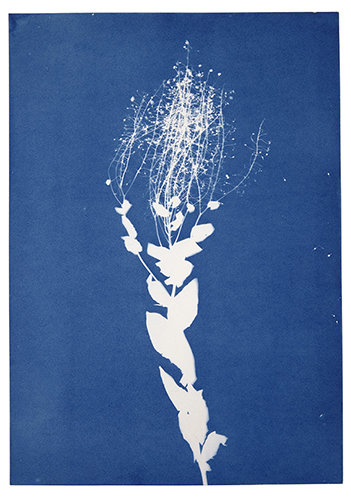
Jessie Brennan, ‘Meadowsweet’, cyanotype, from Inside The Backyard (Opportunity Area), 2015–6.
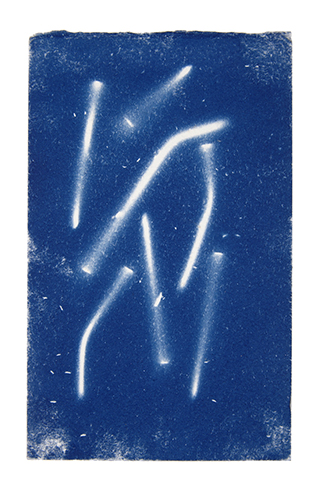
Jessie Brennan, ‘Nails’, cyanotype, from Inside The Backyard (Opportunity Area), 2015–6.
BOM
Carroll/Fletcher Onscreen
CPG London
Furtherfield
Jessie Brennan
Land for What?
Metal Peterborough
Shared Assets
South London Gallery
The Green Backyard
The New Bridge Project
Sophie Antonelli, co-founder of The Green Backyard This piece was written for Re:development, a book brought together by artist Jessie Brennan following her year-long residency at The Green Backyard. Published before the land was finally safeguarded, it traces the journey of transforming a former derelict allotment site into the thriving community growing project that is now The Green Backyard.
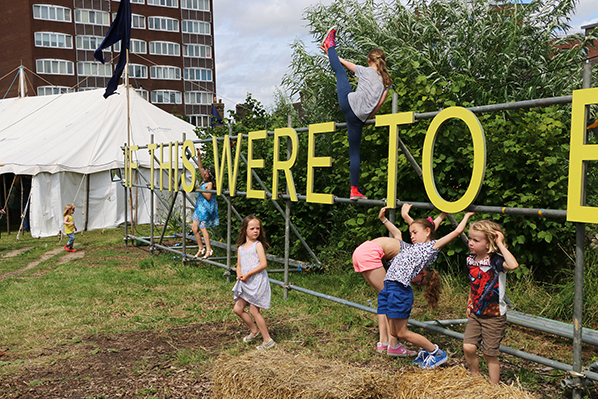
Jessie Brennan, If This Were to Be Lost, 2016, painted birch plywood on scaffold, 1.9 x 19 m, situated at The Green Backyard, Peterborough. Photograph by Jessie Brennan
In early 2009 we first opened the gates to a site in Peterborough that had been closed and unused for 17 years. A 2.3-acre site in the city centre, next to two main roads and the East Coast main line to London should not be hard to miss, but after almost two decades of disuse many people had simply forgotten it existed. I’d like to say that we knew what we were doing at that time, but as is often the case in voluntary groups, the creation of what would become The Green Backyard was motivated by the seizing of an opportunity, in this case offered land, together with a tacit sense of need: to preserve years of learning created by my father on his allotments; to create a space for people to learn and change; and to challenge the momentum of the city, which in my life-time had seemed stagnant and apathetic. At the time I could not have articulated these motivations, and I am now very aware that my own impetus is likely to have differed from others’ around me. I find this to be the case with many community spaces: everyone comes to them with their own very personal set of hopes and needs which are often complimentary, and occasionally divisive. The lessons that grew out of those undefined early experiences of creating a shared space made visible the participatory qualities inherent to the project and fired up the desire for imperfect spaces – rather than meticulously planned ones, with defined budgets and personnel. The threat then imposed by the land owners, our City Council, in response to the slashing of local authority budgets following the 2008 financial crisis, actually served to crystallise this value and catalyse a movement of enthusiasm for radical change in a city long-complacent and passive. The battle to stop the land being sold off for development, I think, surprised everyone. First came the obvious shock when council officers arrived just a few days before Christmas in 2011 and told us of their intention to sell the land… [continues here]
Introduction Jessie Brennan This piece was written for Re:development, a book that brings together voices, cyanotypes and writings from The Green Backyard following my year-long residency there. Published before the land was finally safeguarded, it questions the capitalist logic of the site’s proposed development by the landowner, Peterborough City Council. The book shares the voices of The Green Backyard – of those defending their right to the city.
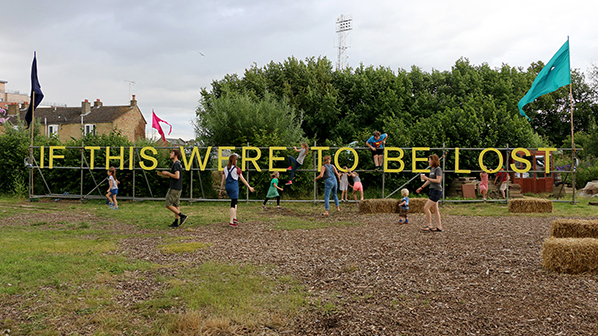
Jessie Brennan, If This Were to Be Lost, 2016, painted birch plywood on scaffold, 1.9 x 19 m, situated at The Green Backyard, Peterborough. Photograph by Jessie Brennan
Among the borage plants there lies a toothbrush, its simple white length surrounded by vivid blue. It’s an object donated by a visitor to The Green Backyard (which is acting as a collection point) for refugees in Calais, and it is one of many hundreds of objects here that seem to invoke the voice of The Green Backyard: offering a conduit through which people close to the project can articulate its value. The objects that call forth the voice reveal, in turn, that those voices also tacitly object: through positive tactics of planting and communing, individuals speak of the necessity of The Green Backyard as public, open, urban green space, and why its proposed development must be resisted. I first set foot inside The Green Backyard, a ‘community growing project’ in Peterborough, in May 2014, at a time when the threat of a proposed development by its owner, Peterborough City Council, was at its most heightened. What brought me to this site were questions of land ownership and value (framed by the long history of community land rights struggles) and the ‘right to the city’: whom the land belonged to. Because, of course, feelings of belonging to a place in no way necessarily mean it belongs to you, as users – visitors, volunteers and trustees – of The Green Backyard are all too well aware. Despite the current social value that this urban green space clearly provides, debates around the proposed development of The Green Backyard (and many other volunteer-run green spaces) have been dominated by arguments for the financial value of the land – referring to the short-term cash injection that its sale would generate – rather than the long-term social benefit of the site… [continues here]

SEE IMAGES FROM THE EXHIBITION
Reference points for a new exhibition by They Are Here
DOWNLOAD PRESS RELEASE (.pdf)
IMAGES FROM THE OPENING EVENT
Furtherfield presents Superdiversity: Picturing Finsbury Park, an exhibition collaboration between researcher and artist Katherine Stansfeld and local people and communities in London’s Finsbury Park. Support gratefully acknowledged from Ordnance Survey, the Economic and Social Research Council, and the Royal Holloway Centre for the GeoHumanities.
“My roots are here, I’m very proud to be where I am, I’m happy to be where I am…I have very good memories and bad I guess, I felt like one of the key things for my children is to make sure they fit in, it’s so important to fit in and feel part of something and I think that was my struggle…” – Finsbury Park worker and ex-resident
Superdiversity: Picturing Finsbury Park questions what the area means for different people. It is an exploration of what place and difference mean in the context of a neighbourhood in today’s London, a global city. It attempts to re-socialise ‘the map’ through a social research practice.
The diversity of contemporary urban life reflects and creates its complexity. This is particularly true of Finsbury Park, an area of London which is home to people from all backgrounds. Conceptualising place as open and shifting, the exhibition focuses on the different ways local place is understood and experienced in the super-diverse area of Finsbury Park. ‘Superdiversity’ is a concept that attempts to conceptualise the complexity, mobility and unpredictability of this form of diversity, recognising the ‘diversification of diversity’.
“The area has got a lot busier. Different types of people are coming in from all walks of life. I saw lots of different faces that I’d never seen before, and it was weird to me at first, but I’ve kind of got used to it now. I’m okay with it now.“ – Finsbury Park resident.
Tens of thousands of people move through Finsbury Park, and people spill off pavements, landscapes alter as buildings rise, and impending verticality threatens sought-after sunshine. This exhibition explores city dwellers’ experiences of the city’s increasing density and accelerated transformation, alongside so many others, and how it affects the meaning of neighbourhood space.
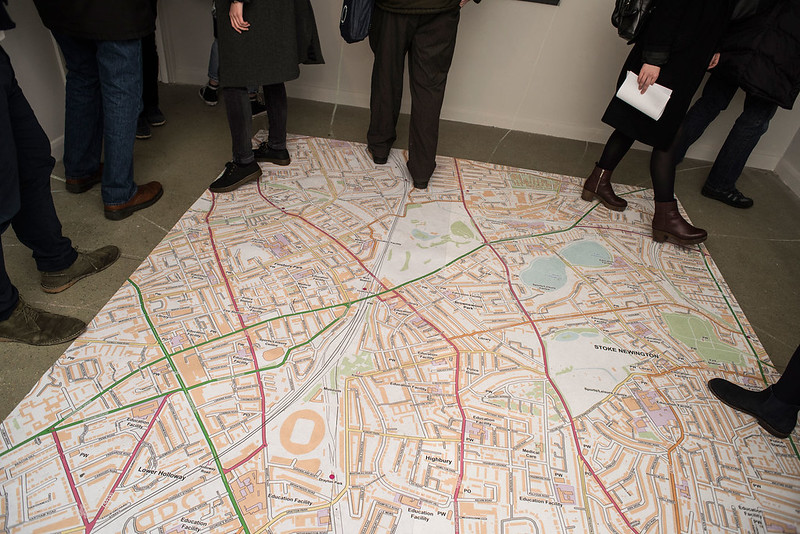
Photographic ‘place portraits’ created by Stansfeld as part of walking interviews acknowledge the everyday places that matter, accompanied by audio narrations by participants explaining their significance. Stansfeld’s films of urban encounters and maps of vernacular geographies, constructed using digital mapping tools, explore whether a new cultural cartography is possible – one that is fluid and dynamic – a shifting platform to express super-diversity.
“It feels more homely being around people from everywhere” – Finsbury Park resident.
Using visual ethnography: video, photography, and mapping, the exhibition explores how lives and trajectories overlap in the area. Stansfeld observes and encounters many different people to find out what type of space fosters conviviality or causes contestation. Through this process, Stansfeld not only uncovers social relations but captures the experience of super-diversity, evoking the particular practices, rhythms and moods that create the urban multicultural place of Finsbury Park.
“Anything old is slowly being knocked down, especially in these parts. I’ve lived in this area since 1994, so 22 years. So I’ve seen things unfolding and things changing for the better even though you’re missing the old faces, some of the old people, they’ve moved on, they’re no longer in this area” – Woodberry Down resident.
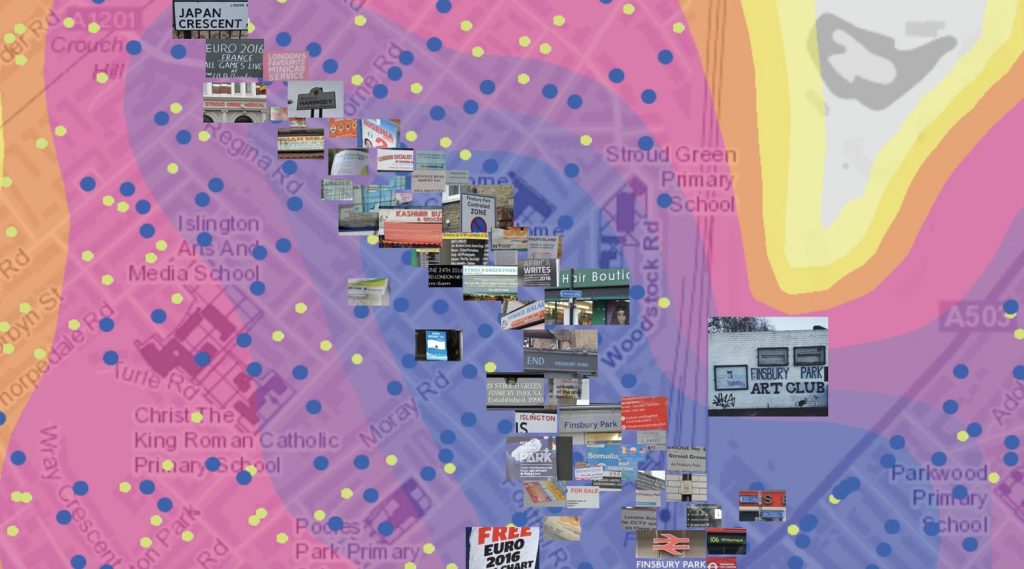
Geohumanities Exhibition Tour and Seminar: The Multiplicity of Place
Wednesday 22 February 2-4pm – Furtherfield Gallery & Commons – BOOK HERE
‘Place is increasingly theorised as elusive, multiple, a constellation of trajectories’ (Massey, 2005). Hosted by Furtherfield in Finsbury Park, N4, this event will combine a short pre-circulated reading with an Exhibition Tour by RHUL PhD student Katherine Stansfeld and Furtherfield co-director Ruth Catlow in order to open up a wider discussion of the multiplicity of place.
FREE – Limited places, booking essential
Passengerfilms presents Conviviality
Friday 24 February, 6-9pm – Furtherfield Commons – BOOK HERE
Join Passengerfilms for an evening of film and discussion on the themes of documentary encounters, multiculture and the city with Marc Isaacs, Emma Jackson, Andy Lee, chaired by Katherine Stansfeld.
FREE – Donation on the door – Limited places, booking essential
Walk and Talk in Finsbury Park
Saturday 25 February, 2-5pm – Furtherfield Gallery
Whether you’re spending your Saturday afternoon outdoors or just passing from A-B, share your stories with researcher Katherine Stansfeld and artist Alison Ballard as you walk through Finsbury Park. They’ll be out and about recording between 2-5pm. If you’d like to share your stories, or just have a chat, pop in to Furtherfield Gallery and ask the invigilators to track them down. They won’t be far away.
Finsbury Park is an area which faces large population churn and includes areas, just streets apart, which vary from being among the 2% most deprived in the country compared to the 50% least deprived. The area straddles official and vernacular boundaries and is home to people from all backgrounds. It sits within Islington, Hackney and Haringey where almost two-thirds of the population, and over 70% of young people are from ethnic minority backgrounds and over 100 languages are spoken. In Islington, a third of the population (36%) were born out of the UK and a quarter of households have an individual with a long term health problem or disability. In Hackney 1 in 10 people define as LGBT and the borough has significantly higher proportions of Buddhist, Jewish and Muslim residents than the rest of the UK.
Furtherfield was founded in 1997 by artists Marc Garrett and Ruth Catlow. Since then Furtherfield has created online and physical spaces and places for people to come together to address critical questions of art and technology on their own terms.
Furtherfield Gallery
McKenzie Pavilion
Finsbury Park, London, N4 2NQ
Visiting Information
Furtherfield Gallery is supported by Haringey Council and Arts Council England.




London’s Permaculture Design Course – Design 4 A.C.T.I.O.N (Active Community Transformation In Our Neighbourhoods) is a different kind of permaculture course – positive design for your life, your community and your world by empowering the genius inside all of us!

D4A is about regenerative learning, enabling individuals, organisations and communities to come together over six weekends to create empowering solutions to the real world challenges we are all facing in these times of change. Adapted from the Permaculture Association (Britain)’s PDC core curriculum, this is a person-centred, fun, lively and inclusive course, exploring and utilising concepts such as Systems Thinking, Holistic Design, Community Empowerment, ‘Whole Person’ Health, Skill Sharing, Critical Thinking, Appreciative Inquiry, Right Livelihoods and much more.
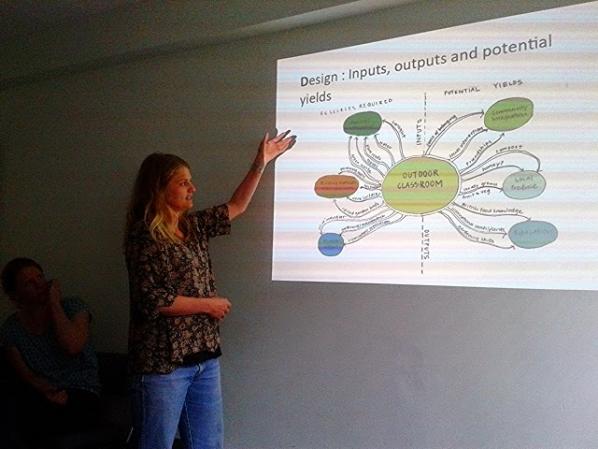
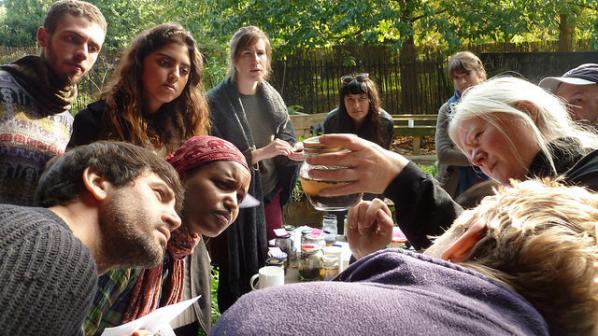
The format is participatory and dynamic using diverse visual, audio and kinesthetic learning methods such as individual and group work, games, problem solving, discussion, observation, field trips, practical activities, lectures and slideshows. This course will be hosted at Furtherfield Commons in Finsbury Park, a new and exciting partnership project at the cutting edges of dynamic cultural change: “We believe that through creative and critical engagement with practices in art and technology people are inspired and enabled to become active co-creators of their cultures and societies.”
Led By: The course will be taught by Graham Burnett (Dip. Perm Des), Claire White (Dip. Perm Des), James Taylor (MSc. Human Ecology) and some great guest teachers.
Dates: 6 weekends, October 2016 – March 2017
29 – 30 Oct 2016
19 – 20 Nov 2016
10 – 11 Dec 2016
14 – 15 Jan 2017
11 – 12 Feb 2017
11 – 12 March 2017
Cost:
£390 – Individual, concessionary rate (unwaged)
£590 – Individual, waged (income less than £25k)
£790 – Individual, waged (income more than £25k)
£790 – Sponsored/organisation rate
IMAGES FROM THE OPENING EVENT
Participating artists: [AOS] Art is Open Source, Cristina Busto, Equipo Sauti ya wakulima, Mary Flanagan, Carla Gannis, Genetic Moo, Fernando Gutiérrez, Lynn Hershman Leeson, Shu Lea Cheang, Gretta Louw & Warnayaka Art Centre, Regina de Miguel, Joana Moll & Cédric Parizot, Guido Segni, Karolina Sobecka, Alan Sondheim, Thomson & Craighead.
Monsters of the Machine is a contemporary take on Mary Shelley’s Frankenstein and asks us to reconsider her warning that scientific imagining and all technologies have unintended and dramatic consequences for the world. It also invites us to ask the same about the arts and human imagination. Shelley’s classic, gothic horror and science fiction novel has inspired millions since it was written 200 years ago in 1816 and then published anonymously in London in 1818. It offers a lens through which to look at the practices of arts and sciences today and how they shape society’s relationship with technology.
Dr Frankenstein plays the role of the Promethean scientist, a creative genius, and also a narcissist tangled up in his own individual desires, exploiting others in an irresponsible and abusive drive to control nature. However, who is the real monster? Dr Frankenstein or the poor wretched mutant he brought to life? Are we Dr Frankenstein, the suffering mutant, or both? This question posed by the exhibition considers the roles of our arts and science traditions and examines these issues as part of everyday life; as they are played out in the Anthropocene, and climate change, gender politics, ethics, governance, surveillance, posthumanism, transhumanism, hacking, biohacking, colonialism, neoliberalism, biopolitics and accelerationism.
In this exhibition, visitors can experience artworks in which the human genome is used as the basis for a poetry machine for a self-assembling video montage spanning thirteen years – a memorial work and an algorithmic visualisation for a historic scientific landmark. 3d printed avatars representing distorted bodies in pain, about virtual worlds where there’s no geography, and the result is the crack/wound, everywhere and nowhere. Visitors participate in a software-driven installation, a performative social neuroscience experiment, to discover our shared psychological biases. A surreal video installation shows us a dystopian blend of ‘reality’ out in the remote Australian desert with traditional ghost stories and Dreamtime stories mixed with science fiction. The Sahara Desert is remapped by a custom bot in an algorithmically scripted performance, traversing the data-scape of Google Maps and filling a Tumblr blog and its data centres. Artists take our bio-matter and the inconceivable quantities of data we generate in our daily lives as materials with an inherent recombinant intelligence and the power to generate (without the intervention of human will) the narratives of human destiny and more. Do we inhabit our own bodies anymore, or do we share our body materials for others to measure, reshape and construct, data-scrape and manage remotely? Arthur Kroker in Body Drift: Butler, Hayles, and Haraway say that “we no longer inhabit a body in any meaningful sense of the term but rather occupy a multiplicity of bodies – imaginary, sexualized, disciplined, gendered, labouring technologically augmented bodies.” [2]
Artists and scientists work with the same tools, frameworks and archetypes. There are crossovers. Unsurprisingly, we find the boundaries of imaginative fantasy and objective reality breaking down. Take, for instance, the jellyfish invasions around nuclear reactors in Japan, Israel, Sweden, and the Scottish plant in Torness. The natural world is writing its own science fiction into a new reality with vivid images and outlandish outcomes. Right now, the classic techno-utopian dream of computers liberating us all and providing the tools that will underpin global democratisation seems a long way off and even somewhat sterile. Since the news stories broke of mass surveillance of Internet users by NSA and Prism, we’ve experienced new formulations of mutual surveillance and manipulation daily. So now we stand at a precipice; what choice do we have but to jump into this sea of dysfunctional dystopias, and directly observe for ourselves, what we have become and what we will be, the Monsters of the Machine?
Notes:
[1] Body Drift: Butler, Hayles, Haraway (Posthumanities). Author Arthur Kroker. University of Minnesota Press (22 Oct. 2012).
[2] Body Drift: Butler, Hayles and Haraway. Review by Marc Garrett 15/08/2015.
http://www.furtherfield.org/features/reviews/body-drift-butler-hayles-and-haraway
The exhibition draws upon ideas originally written in an essay. Prometheus 2.0: Frankenstein Conquers the World! Marc Garrett.
http://www.furtherfield.org/features/prometheus-20-and-our-god-complex
Curated by: Marc Garrett, co-founder of Furtherfield.org
Graphic Design: Carmen Vázquez
With the support of:
DOWNLOAD PRESS RELEASE (.pdf)
SEE IMAGES FROM ACCOMPANYING EVENTS
LISTEN to a recording of the conversation with John Conomos and Steven Ball at Furtherfield Gallery
Deep Water Web is a free exhibition at Furtherfield Gallery in London’s Finsbury Park, connecting opposite sides of the Earth to understand human impacts on the environment and the wider consequences for people living in both locations.
Artists Steven Ball (London, UK) and John Conomos (Sydney, Australia) have collaborated to present a multi-projection installation where London and Sydney are continuously connected across time zones. The exhibition is an immersive experience which the artists have termed a ‘hyperlandscape’ including real time streaming waterscapes and multiple local manifestations of global ecologies with their own sonic environments and narrated reflections.
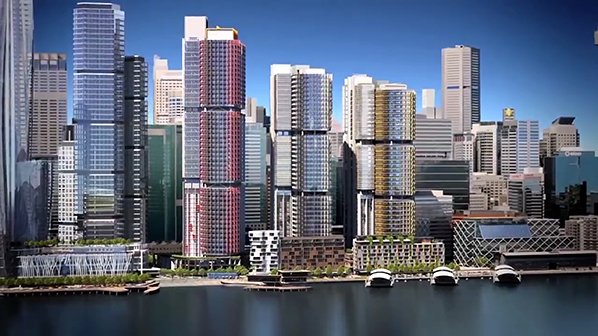
Deep Water Web is a poetic meditation around contemporary and historical geopolitical contexts, underscored by London and Sydney’s situation around large bodies of tidal water in the forms of the River Thames and Sydney Harbour. These bodies of water bear material evidence of the local impact of global warming, such as rising tide levels caused by melting ice caps, leading to flooding, and increasingly extreme climate fluctuation. Both cities are also centres of neoliberal capitalism, inscribing the effects of privatisation, fiscal austerity and deregulation of markets across the planet.
Deep Water Web weaves rhetorical explication of postcolonial relationship, elaborating the precarious material forms of climate change, and post-labour late capitalist neoliberal urban developments of waterfronts of former Docklands, considered within the geological and rhetorical ecology of the Anthropocene.
The age of global warming and global neoliberal capitalism are figured here as critical rhetorical realms. These phenomena can be described as what Timothy Morton has called hyperobjects, objects so massively distributed in time and space as to transcend localisation. While they are impossible to comprehend at scale, hyperobjects exert a profound effect at a local level.
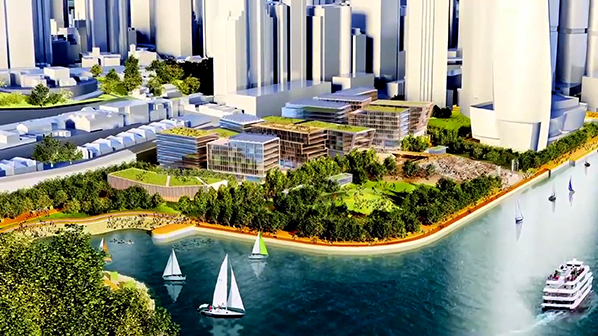
Deep Water Web will also become a catalyst for a workshops series at Furtherfield Commons, which will extend its themes through media based excavations. [dates and full details to be confirmed]
Both artists both have long standing moving image based practices and an interest in landscape and the representation of place. As a hyperlandscape this project suggests that questions of relationship to place, and the construction of landscape, can in the Anthropocene no longer be considered as simply pictorial representation or subjective experience, but is constituted from a range of critical, ethical, ecological, and political positions and concerns.
+ MORE INFO: http://deepwaterweb.net
Deep Water Web is supported by Arts Council England.
Exhibition Tour with artist Steven Ball
Tuesday 4 October 2016 – 5:30-6:15pm – Furtherfield Gallery
Revolutions and Complex Systems
Every Tuesday for 6 weeks
6:30 – 8:30pm at Furtherfield Commons – from 27 September 2016
BOOKING ESSENTIAL
A conversation with John Conomos and Steven Ball
2-3pm Saturday 29 October – Furtherfield Gallery
Booking is essential for this free event
Furtherfield in partnership with the antiuniversity and Radical Think Tank are proud to present this new 6-part course led by Graham Jones.
Aimed at people with an interest in social change, the course will apply concepts from complex systems theory to understanding revolutions and social movements. Sessions will involves a mix of speaker presentation and participatory discussions/activities, covering subjects such as ecology, network theory and new materialist philosophy.
Graham Jones is an activist based in East London, working with groups such as Radical Assembly, Radical Housing Network and Radical Think Tank. Booking Essential.

Steven Ball is an artist, writer and academic based in London, working with audio-visual media engaged with landscape and spatial representation, in local and global, social, political and post-colonial spheres. Since 2003 he has been Research Fellow at Central Saint Martins and was instrumental in developing the British Artists’ Film and Video Study Collection.
John Conomos is an artist, critic and writer based in Sydney, Australia. His books, essays and artworks are framed within four traditions of contemporary art: Anglo-American and Australian cultural studies, critical theory and post-structuralism. He is a New Media Fellow of the Australia Council for the Arts, and Honorary Professor at Victorian College of the Arts, University of Melbourne.
Furtherfield was founded in 1997 by artists Marc Garrett and Ruth Catlow. Since then Furtherfield has created online and physical spaces and places for people to come together to address critical questions of art and technology on their own terms.
Furtherfield Gallery
McKenzie Pavilion
Finsbury Park, London, N4 2NQ
Visiting Information
Furtherfield Gallery is supported by Haringey Council and Arts Council England
Artist collective THEY ARE HERE invite you to play with and test software that allows wireless-enabled computers and mobile devices to directly form a spontaneous communication network independent of the internet.
Across a series of drop-in sessions facilitated by THEY ARE HERE, games and experiments will be trialled as part of the development process for their forthcoming exhibition at Furtherfield in October 2016.
These activities will take place online & offline around Finsbury Park.
Please bring a wi-fi enabled device to the workshop and if possible download the software Qaul.net in advance (qaul.net/software.html.)
No experience is necessary. Each session will be a discrete event, so you can attend as many or as few as you care to.
Join THEY ARE HERE at any of the following meetings at Furtherfield Commons, Finsbury Gate, Finsbury Park.
Session 1: 3pm Sunday 14th August 2016
Session 2: 3pm Sunday 28th August 2016
Session 3: 3pm Sunday 11th September 2016
Session 4: 3pm Saturday 24th September 2016
You must be aged 16 yrs +
Email contact(at)theyarehere.net for further information.
Date:NOW
Venue:HERE Links:http://www.crowdfunder.co.uk/artists-rethinking-the-blockchain?tk=208334da9b174c..
WE WANT your submissions to this landmark publication marking and augmenting the arrival of a new technology on the cultural landscape.
THE BLOCKCHAIN is widely heralded as the new internet – another dimension in the ever-faster ever-more-powerful interlocking of ideas, actions and values. [1]
It’s nothing more than a ledger distributed across a large array of machines. An apparatus that enables digital ownership and exchange without a central administering body. But from these simple premises, it has been credited with the potential to transform everything, from trade, to cultural production, to the way we’re governed.
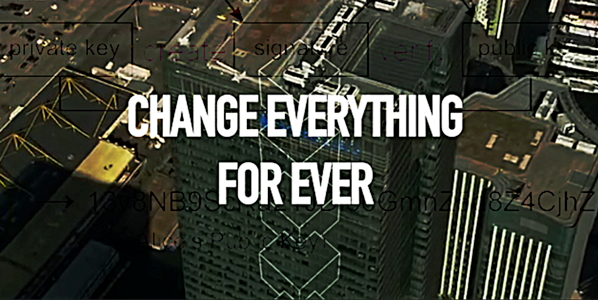
Among other things, we are suspicious of cultural production being brought under the same regime as finance.
Even as we write, this “new dawn” for transactions is being re-imagined as the next sleep-cycle taking us deeper into the neoliberal dream of complete financialisation. In this dream, Finance and Technology quicken their demented mining of value tokens from phenomena, while the grammars of culture, family, nature, politics and spacetime itself evaporate into a flurry of question and exclamation marks in their wake.
“It’s going to change everything!” (The Guardian)
The permanence and irrevocable automation of blockchain systems wedded to the irrationality and sweep of techno-financial hybrids has led to forecasts ranging from ‘fully automated luxury communism’, to our ultimate cryptological enslavement to machines, or the collapse of time itself, as the feature of algorithms to make-happen overtakes the temporal concerns of flesh and earth.
Artists Re:thinking The Blockchain
This book is not a site for a ludic cynicism or uncritical valorisation, though it celebrates the energies of these excessive forms of thinking. We welcome the potentials for ever more nuanced democratic apparatus, and the decentralization of power from state-corporation cabals, while rejecting the notion that any single technology would automatically enact these ideological transformations. We seek also to register and amplify the leakages, weirdness and side-effects that this new technology inaugurates.
Imagined as a future-artefact of a time before the blockchain changed the world, and a protocol by which a community of thinkers can transform what that future might be, Artists Re:Thinking The Blockchain acts as a gathering and focusing of contemporary ideas surrounding this still largely mythical technology.
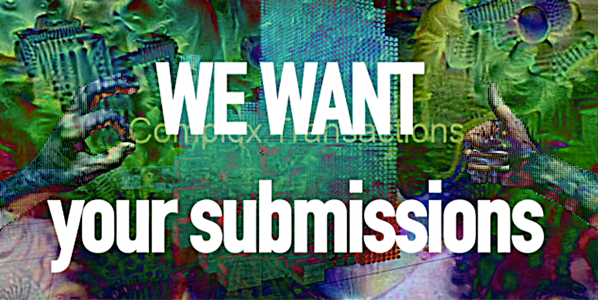
The book will include examples and discussions of current artistic projects making use of and illustrating the potentials of the blockchain, theorisation from some of the leading figures in the global blockchain conversation, and practical discussions which artists can use to guide their first steps towards this new technology.
We welcome submissions of
· book-based artworks which reflect on blockchain themes
· science fictions and theorisations, particularly in their hybrid form
· proposals for documentation of online and irl artworks
· poems, particularly based on the ‘new book’ and formal constraint txtblock [2]
The publication is a collaboration between Torque and Furtherfield, connecting Furtherfield’s Art Data Money project with Torque’s experimental publishing programme.
Alongside an illustrated print edition, the project includes a range of public-participation and debating sessions in towns and cities up and down the UK, and the first-ever book launch taking place on the blockchain itself.
DEADLINE FOR PROPOSALS 15th August
– up to 500-word abstract, description or sample of your proposed submission
– a short bio
– website link (optional)
mail to: mail@torquetorque.net
DEADLINE FOR FINAL SUBMISSIONS will be 1st October
torquetorque.net || furtherfield.org
https://www.facebook.com/torquebooks
#artblockbook
Contact: mail@torquetorque.net
Furtherfield in partnership with the antiuniversity and Radical Think Tank are proud to present this new 6-part course.
Aimed at people with an interest in radical social change, the course will apply concepts from complex systems theory to understanding (and creating) revolutions and social movements.
The course is directed at a general rather than academic audience, although a desire for radical social change will be assumed.
6.30 – 8.30pm at Furtherfield Commons, inside the park near Finsbury Gate
Booking essential – Please book here
Tue 27 Sept – Introduction to Complex Systems
Tue 4 Oct – Smash the System – Creating and Harnessing chaos
Tue 11 Oct – Erode the System – Building the New World in the Shell of the Old
Tue 18 Oct – Escape the System – Bodily Affect and Surviving Oppression
Tue 25 Oct – Tame the System – Reforms without Reformism
Tue 1 Nov – Bringing it All Together – A Trajectory for Revolution
Sessions will involves a mix of speaker presentation and participatory discussions/activities, covering subjects such as ecology, network theory and new materialist philosophy.
Other familiar concepts will be re-examined through this framework, including the commons, chaos, structural oppression and reform.
The ultimate goal is for this knowledge to be put into practice to create more effective activism, to contribute to better understanding the workings of contemporary society and to help inspire projects for building future utopian alternatives.
Graham Jones is an activist based in East London, working with groups such as Radical Assembly, Radical Housing Network and Radical Think Tank.
For those unwaged or on low income the course is free (or donate what you can). Choose either the Free Ticket or Donation ticket in the links above.
For everyone else, individual sessions are £5 + booking fee. A prebooking of all 6 sessions is available for £25 + booking fee.
FREE Exhibition Tour and Artists Talk: Sat 18 June, 2-4pm
DOWNLOAD PRESS RELEASE (.pdf)
SEE IMAGES FROM ACCOMPANYING EVENTS
Featuring Gretta Louw, Lily Hibberd, Brook Andrew, Curtis Taylor, Jenny Fraser, Sharon Nampijinpa Anderson and the Warnayaka Art Centre.
Networking the Unseen is the first exhibition of its kind to focus on the intersection of indigenous cultures and zeitgeist digital practices in contemporary art.
While digital networks manifest physically as tonnes of cabling, and electrical or electronic devices, the social and cultural impacts of the networks remain somehow invisible, eroding clearly felt boundaries of geography, place, culture and language.
Together with artist and curator Gretta Louw, Furtherfield presents an exhibition and event series that brings together concepts and experiences of remoteness and marginalised cultures, with art-making in contemporary society.
Five culturally and geographically disparate Australian artists – Gretta Louw, Jenny Fraser, Lily Hibberd, Brook Andrew, and Curtis Taylor – and artists, including Neil Jupurrurla Cook, Isaiah Jungarrayi Lewis, and Sharon Nampijinpa Anderson from the Warnayaka Art Centre in Central Australia, present work situated at the intersection between avant garde digital, media, and installation art, the sociological study of digital and networked culture, and activism.
Networking the Unseen proposes a radical rethinking of widely accepted stereotypes concerning the impact of networks on contemporary global cultures, digital art, the avant garde, and indigenous art-making.
It tackles subjects ranging from digital colonialism and cultural marginalisation (or, conversely, diversity/empowerment) within an increasingly connected, online world to universal concerns around cultural change as a result of technological migration.
The exhibition extends our focus to the extremities of the global digital network. It subtly proposes ways to claim power back from centralising forces of control to use these tools for positive change; for intercultural exchange and empowerment for marginalised communities.
The Phone Booth Project, by Paris-based Australian artist Lily Hibberd and Martu indigenous filmmaker and artist Curtis Taylor, is a multimedia installation that demonstrates the intricate relationship between community and technology and how this is uniquely affected by local circumstance and environmental factors. Phone booths have all but died out in urban environments, and yet this beautiful and nuanced work, created in the Western Desert region of rural Australia with the indigenous Martu communities, highlights the vital role that they continue to play at the edges of the network – where cell phone reception is often non-existent, and landline phone connections in every house are an infrastructure expense that neither the locals nor the government is willing or able to carry.

Brook Andrew is an internationally recognised Australian artist whose practice in installation, print, neon, and performance often draws on his Wiradjuri indigenous heritage. In Costumes for the Cell (2012) Andrew’s instantly recognisable digitally-facilitated contemporary revision of a traditional Wiradjuri pattern – a powerful example of the blending of old and new culture; tradition and technology – becomes a moving installation as it is worn by performers at the opening.
Gretta Louw’s ongoing collaboration with artists from the Warnayaka Art Centre has produced the two video works Digital Desert and Is the Desert Still the Desert in a Digital World? in 2012, followed in 2014 by the YAMA project – an immersive, on-site multimedia installation built in the remote central Australian desert. The immersive installation at Furtherfield manifests the physical installation in wall paintings, screens, and light. It invites us to explore the nature of cultural change brought about by the arrival of advanced digital technologies.

Name That Beach, a video work by a fore-runner of the indigenous digital art movement Jenny Fraser, is programmed alongside works by emerging artist Curtis Taylor in a fascinating and inspiring insight into contemporary digital media art-making in Australia.

The works in the exhibition invites reflection by non-indigenous audiences on the techno-cultural change within their own society, and their individual relationship to internet technologies.
Exhibition Tour and Artists Talk
Saturday 18 June 2016 – 2-4pm – Furtherfield Gallery & Commons
Join Neil Jupurrurla Cook, artist and Director of the Warnayaka Art and Aboriginal Cultural Corporation, and Gretta Louw, artist and curator, for a curated tour of Networking the Unseen and then head down to Furtherfield Commons for a Show and Tell about their collaboration and work.
FREE – Limited places, booking essential (register)
Free family workshops at Furtherfield Commons
Every Saturday from 23 July to 27 August, 2-4pm
Fun, interactive workshops for local families aged 5 upwards.
Details to be confirmed – Register your interest here
Young digital artists residency at Furtherfield Commons
25 July – 5 August, Monday-Friday, 11am-4pm
Adventures in arts and technology for young people 13-18 living in or attending school in Islington.
Details to be confirmed – Register your interest here
Networking the Unseen – Selfies and Alterity
Thursday 4 August, 6-8pm – Furtherfield Gallery & Commons
6-6.45: Gretta Louw will give a tour of the exhibition Networking the Unseen at Furtherfield Gallery.
7-8 join us at Furtherfield Commons where she will present preliminary work on a Warlpiri (First Nations Australian) selfie and photo editing app, a collaboration with the Warnayaka Art Centre, and discuss the ways in which your emojis are not innocent, digital colonialism, and how selfies, social media, and alterity can be used for social good.
FREE – Limited places, booking essential (register)
Do It With Others – Art and Solidarity in the Age of Networks
Saturday 6 August, 12-5pm – Wysing Poly, Wysing Arts Centre, Bourn, Cambridgeshire.
With Ruth Catlow, Marc Garrett, Gretta Louw, Tim Waterman and They Are Here
This day long symposium explores art as a commons (defined as the cultural and natural resources accessible to all members of a society) in the age of networks and neoliberalism. How can the practices, circulation, appreciation and stewardship of arts be emancipated for all? Exploring tensions between digital inclusion and cultural diversity in the digital global hegemony.
FREE – Limited places, booking essential (register)
Brook Andrew is an internationally acclaimed Australian artist of indigenous (Wiradjuri) and Celtic descent. He has had significant exhibitions at world class institutions like the Museo Nacional Centro de Arte Reina Sofia and the Tate Britain, and been part of numerous international showcases, such as the Asia Pacific Triennial of Contemporary Art and the Asian Art Biennial. Andrew’s practice is intensely research-based, resulting in interdisciplinary works and immersive installations.
Jenny Fraser is a screen-based artist, curator, and educator. Her work utilises popular cultural references as a bridge to challenge viewers’ frames of reference. She redefines the art of curating as an act of sovereignty and emancipation, and founded the groundbreaking cyberTribe online gallery over a decade ago. A Murri of mixed ancestry, Fraser has received many accolades for her trailblazing work, most recently being awarded a prestigious Australia Council Fellowship in 2012 for her project Midden.
Lily Hibberd is an Australian artist and writer, working between Sydney and Paris. Her practice centres on marginalised people and histories and the restoration of memory through interdisciplinary collaborative social practice. Hibberd’s recent project include major exhibitions at the Musée des art et métiers (2015-16), Paris, and Spaced 2: Future Recall for Perth International Arts Festival (2015).
Gretta Louw is a multi-disciplinary artist and writer exploring the potential of art as a means of investigating cultural and psychological phenomena, particularly in relation to new technologies and the internet. Born in South Africa, she grew up in Western Australia and is currently based in Germany. Her work has been exhibited widely – in New York, Berlin, Jakarta, and Tel Aviv, amongst others – including in a number of public institutions such as the Kunstmuseum Solothurn, Stadtgalerie Mannheim, and Kunstverein Ludwigshafen.
Sharon Nampijinpa Anderson is an artist and educator and one of the directors of the Warnayaka Art and Cultural Aboriginal Corporation. Born near Mt Doreen in the Tanami Desert, Nampijinpa holds a degree from Bachelor College in Darwin, Australia has exhibited her art work widely, including at Galerie Yapa in Paris, Cooee Aboriginal Art Gallery in Sydney, and at the Darwin Aboriginal Art Fair. Nampijinpa is passionate about preservation of Warlpiri culture and has been involved in numerous projects to this end, such as the Arts Workers Extension Program in Australia and the production of the 2013 publication Warnayaka Art Centre: Life in the Digital Desert (Ed Gretta Louw).
Curtis Taylor is an emerging Martu Australian filmmaker and video artist. He has had screenings of his work at the National Gallery of Australia, the Fremantle Arts Centre, the Western Australian Museum of Art, and many more public institutions. Taylor is also currently involved in the VR film project, Collisions, which is debuting at the Sundance Film Festival.
Warnayaka Art Centre is a nationally renowned Australian indigenous (Warlpiri) art centre. The centre is home to a number of internationally successful Warlpiri painters including Lily Nungarrayi Hargraves and Molly and Rosie Napurrurla Tasman. Neil Jupurrurla Cook is the lead media and installation artist; he is the Director of the Warnayaka Art and Aboriginal Cultural Corporation and has shown his sculptural and media installations at the Darwin Art Museum.
Furtherfield was founded in 1997 by artists Marc Garrett and Ruth Catlow. Since then Furtherfield has created online and physical spaces and places for people to come together to address critical questions of art and technology on their own terms.
Furtherfield Gallery
McKenzie Pavilion
Finsbury Park, London, N4 2NQ
Visiting Information
Join us on August 4th between 6 and 6.45 for an exhibition tour by Gretta Louw at the Furtherfield Gallery.
Then from 7-8pm, we will continue at Furtherfield Commons with Your Emojis Are Not Innocent: Selfies and Alterity, a presentation by Louw, in which she will present her upcoming collaboration with Warnayaka Art Centre to create a Warlpiri selfie and photo editing app, and a discussion about how selfies, social media, and alterity can be used for social good.
Gretta Louw is an artist, writer, and curator working predominantly with digital media, social practice, and networked performance, whose work explores the potential of art as a means of investigating cultural and psychological phenomena, particularly in relation to new technologies and the internet. For the last five years she has been deepening her research into cultural change brought about by, or happening in interaction with, digitalisation. She has a long standing collaboration with the Warnayaka Art and Cultural Aboriginal Corporation, a Warlpiri First Nations art centre in the remote community of Lajamanu in central Australia. The current exhibition at Furtherfield Gallery, Networking the Unseen, is a curatorial project born out of Louw’s collaboration with Warnayaka and Warlpiri artists like Neil Jupurrurla Cooke, Isaiah Jungarrayi Lewis, and Sharon Nampijinpa Anderson. The exhibition investigates themes of digital colonialism, contemporary indigeneity, digital and media art from outside the urban mainstream, and the ways in which digital media can be used either to perpetuate inequality or as a tool of social empowerment.
FREE – Limited places, booking essential (register)
Calling 13-18 year-olds!
Become a digital media artist. Design your own digital game, make a robot, or design a selfie app. Create small ‘geocached’ artwork for people to find in Finsbury Park, or narrate an audio guide for gallery visitors. Meet and learn with leading artists, and at the end of the programme you can keep your own ‘Raspberry Pi’ pocket computer
FREE, booking essential, limited places so BOOK HERE NOW
For more information contact: alicia.furtherfield@gmail.com
Young Digital Artists in Residence: Adventures in Art and Technology is part of Islington Council’s Summerversity programme.
Exhibition Tour and Artists Talk (Neil Jupurrurla Cook and Gretta Louw)
Meeting point: Furtherfield Gallery
Join Neil Jupurrurla Cook, artist and Director of the Warnayaka Art and Aboriginal Cultural Corporation, and Gretta Louw, artist and curator, for a curated tour of Networking the Unseen and then head down to Furtherfield Commons for a Show and Tell about their collaboration and work.
FREE – Limited places, booking essential
Contemporary indigeneity, understanding Warlpiri (Australian First Nations) culture and law – and how these encompass art-making, and the relationship between tradition, culture and technology. Join Gretta Louw, Neil Jupurrurla Cook, and Warlpiri scholar and educator Wanta Jampjinpa Patrick, in an informal discussion and presentation on these and other themes at Furtherfield Commons. A Q&A session moderated by Furtherfield directors Ruth Catlow and Marc Garrett will open up the floor to visitors.
At the talk at Furtherfield Commons, there will also be a rare opportunity for Furtherfield visitors to purchase a painting, ethically sourced and sold directly by the Aboriginal-owned art centre. This curated selection of canvases are by some of Warnayaka Art Centre’s most acclaimed artists, including senior law women Lily Nungarrayi Hargraves, Rosie Napurrurla Tasman, and Molly Napurrurla Tasman.
DOWNLOAD PRESS RELEASE (.pdf)
Venue: Southbank Centre, London
Links: http://www.southbankcentre.co.uk/whatson/liliane-ljin-power-game-98125
Follow in the footsteps of Derek Jarman and gamble on the power of words in a casino of ideas.
Take a seat at the table with artist Liliane Lijn, Hayward Gallery Director Ralph Rugoff, author Ali Smith, poet Sabrina Mahfouz, technology guru Vinay Gupta and digital artist Alan Warburton for a night which promises to be as inspirational as it is provocative.
When playing cards, everyone knows that the Queen trumps a Jack, and they gamble accordingly. But how should you bet on the words ‘protest’, ‘logic’ or ‘love’?
Presented by Southbank Centre in partnership with Furtherfield, Power Game is both a game and a live, unrehearsed performance that uses gambling as a lens on the politics of identity and power. It holds up a mirror to our preconceptions and fantasies of power, and forms a metaphor for the system we call ‘democracy’. There are no actors, no rehearsals and no script.
Descend to the basement and gather in a pop-up cafe bar where recordings of previous Power Games are projected on the walls. The bold can buy a single chip to enter the casino and encounter a cross-dressed croupier, who presides over a constellation of artists and thinkers from the worlds of literature, music and politics.
Each of these players is ‘power-dressed’, and you may wish to dress in your own idealised costume of power.
At the table, the elite players wager their own money on the power of the words in their hands, weighting the odds in accordance with their confidence in their own powers of oratory and persuasion. If you’re feeling lucky, you could even take a seat at the table yourself. The Power Game begins…
Created by the artist Liliane Lijn, Power Game was first staged in 1974. At the heart of the game are the invited players, who in 1974 included figures such as Derek Jarman and Patrick Seale, chosen for their wit, originality and influential economic, political or cultural perspectives.
Each live performance is filmed from beginning to end and is simultaneously broadcast live on screens in the casino and the cafe bar. The live feed of each performance is interwoven with footage of past performances, creating a video record of Power Game that grows in depth and complexity with each new playing of the game.
Spirit Level (Blue Room) at Royal Festival Hall
For ages 18+
Please note, this free event requires a ticket. Please book your free ticket online, by phone or in person (no fees apply).
Power Game by Liliane Ljin is presented by Southbank Centre in partnership with Furtherfield
As part of Furtherfield’s Art Data Money programme

Venue: Netbehaviour and Neterarti
Links: http://neterarti.furtherfield.org
Join a conversation about accelerationism on the Netbehaviour email discussion list and Neterarti social media platform: form 21st April – Tuesday 19th May 2016.
Back in 2013 Alex Williams and Nick Srnicek published the influential “#ACCELERATE MANIFESTO for an Accelerationist Politics” which proposes an embrace of automation and the tools and strategies of capitalism for species survival against the odds. It rejects other resistance strategies of protest, occupation, culture-jamming and strike, as outmoded and ineffective in the face of Neoliberal strategies.
The Accelerationist Reader published by Urbanomic pulls together texts and authors, new and old to elaborate and provide historical precedents and contrasts for the position. There have been many responses in Furtherfield’s own networks, including those by Rhea Myers and Robert Jackson, and more widely in academia and contemporary art practice, such as the simultaneously compelling and repulsive Additivist Manifesto by Daniel Rourke and Morehshin Allahyari.
We invite you to join an open discussion about the ideas, potentials, and political and social tensions, as a way to help bridge between academic conversations to wider practice and everyday experience.
We have invited a number people who we think are working in related areas, to join us and contribute. Please do the same yourselves.
Here on Netbehaviour we have a great platform and community for extended debate, and also we suggest http://neterarti.furtherfield.org as a parallel place for pithy summaries and illustrations (pictures and video) as a way to share key topics and themes with a wider world. As always, we aim for jargon-busting clarity. Monday 21st March – Thursday 7th April 2016.
#ACCELERATE MANIFESTO for an Accelerationist Politics
by Alex Williams and Nick Srnicek 2013
Critique by McKenzie Wark of Inventing the Future: Postcapitalism and a World Without Work by Nick Srnicek and Alex Williams
Response to Common Criticisms by Srnicek and Williams
Escape Velocities by Alex Williams
SEE IMAGES FROM THE PRIVATE VIEW
Furtherfield Gallery is proud to present Dimensioning – Live Architecture an exhibition of new digital artworks by Italian artist Chiara Passa, part of Furtherfield’s Open Spot programme.
Passa’s concept of «super places» and her search for new dimensions, or “campo piu’ in là” (a “further field”) underpin her work using architecture as an interface to understand the possibilities of the digital dimension. She uses augmented and virtual reality (AR & VR) to create interactive installations in which the technologies punch through and pull out a new sense of place in combinations of interior, architectural and natural environments.
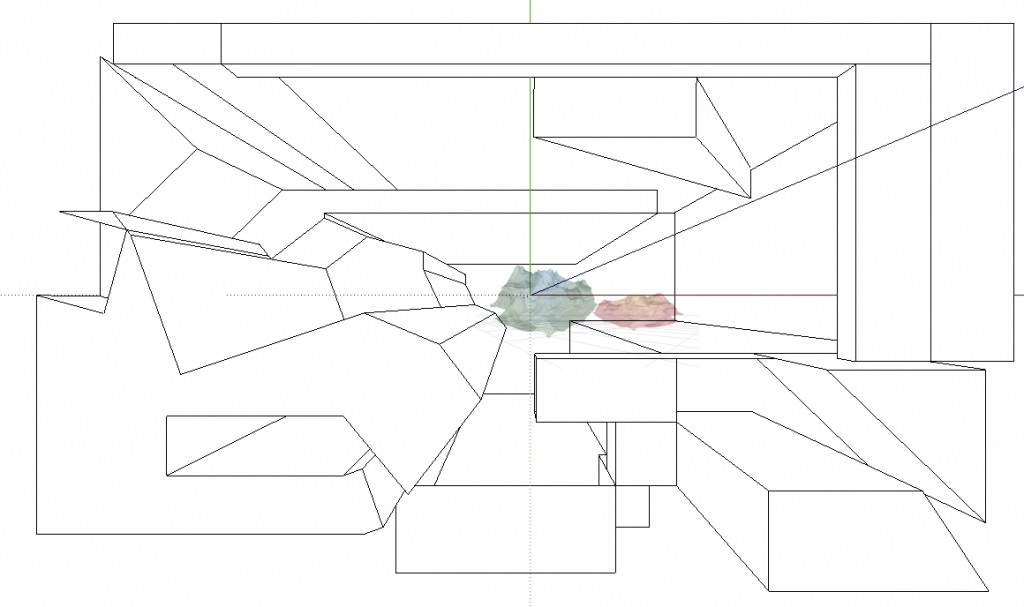
In this exhibition visitors can explore her new digitally mediated perception of space and time in an animated multi-dimensional ‘trompe l’oeil’ of the gallery rooms as 3D wireframe view. Visitors stand in the middle of the “window-camera” view of the software, which has also been used to build the animations on display. They use augmented reality to “travel through” the walls, into the diagrams.

“Worlds open the doors to other worlds and synthetic shapes become design, structure, architecture and reality.”
Passa’s work offers a refreshingly passionate approach to experimental and philosophical play with technologies. We think that this is especially valuable in an age where our expressive range and behaviour is increasingly pre-determined by the digital tools, techniques and devices that we use daily, and the interests, experiences and values of those who create them.
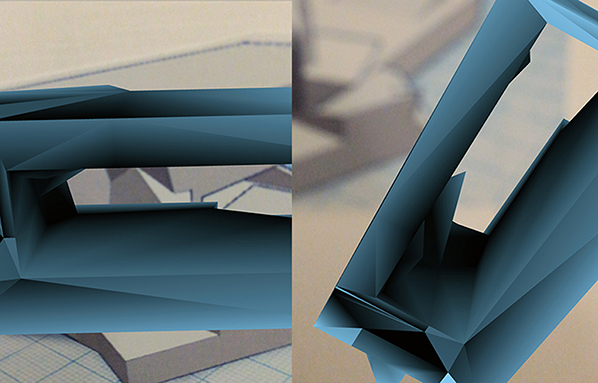
Also for this exhibition visitors will experience her VR 3D animation using a Google Cardboard viewer.
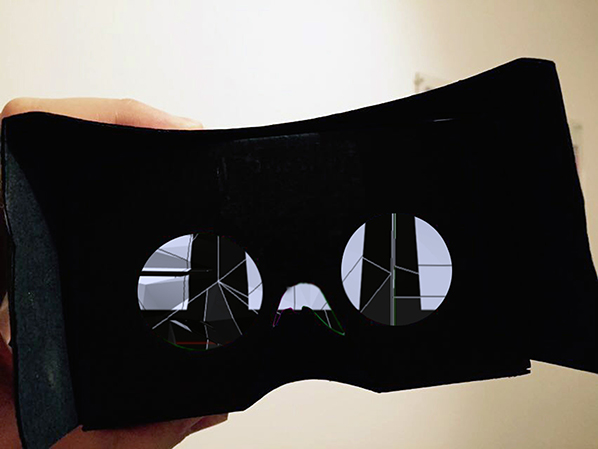
Chiara Passa talks about Dimensioning – Live Architectures at Furtherfield Gallery in the video below
Chiara Passa, media artist (Rome 1973). Graduated at Fine Arts Academy of Rome; master in new audio-visual mediums at the Faculty of Modern Literature.
Her artwork combines many media and platforms analysing changes in ‘liquid space’ through a variety of techniques, technologies and devices – often constructed using augmented reality and the virtual reality technologies. She works with animation and interactive video-installation; digital art in public space as site-specific artwork and video-mapping; video-sculptures and objects; art-applications and widgets for mobile platforms.
She explores the potentials offered by the intrinsic languages of these emerging platforms to experimenting in a rigorous and personal way with the full expressive range and “unknown creative possibilities that the new media are continuously offering to me”. She received the E-Content Award (2012). Her work is regularly exhibited internationally in galleries and at festivals, conferences and institutions including ISEA, Vortex Dome (USA), Media Art Histories Conference (DE), Electrofringe (AU), FILE | Electronic Language International Festival(BR), CCCB – Centro de Cultura Contemporània de Barcelona (ES).
Furtherfield is a leading organisation for art, technology and social change. Furtherfield Gallery and Commons spaces in the middle of London’s Finsbury Park explore complex themes relating to digital culture, inspiring diverse people to get involved with arts and technology on their own terms. Debate is facilitated amongst an active international community of artists and thinkers via online platforms, combined with accessible art shows and labs to enable co-creation and widen participation. Furtherfield is a not-for profit, artist led organisation, an Arts Council England National Portfolio organisation, supported by Haringey Council.
The Furtherfield ‘Open Spots’ programme of self-initiated and self-funded exhibitions and events support the presentation of new work and artistic invention, to discover new perspectives on the horizon of a wider networked society.
Curators and artists that meet Furtherfield’s selection criteria can showcase work at Furtherfield Gallery in the heart of London’s Finsbury Park. Open Spot projects can reach a new, diverse audience of gallery visitors, park users and Furtherfield’s online participants.
London’s Permaculture Design Course – Spring Into Action! and Design 4 A.C.T.I.O.N (Active Community Transformation In Our Neighbourhoods) are a different kind of permaculture course – positive design for your life, your community and your world by empowering the genius inside all of us! The format is participatory and dynamic, using diverse visual, audio and kinesthetic learning methods such as group work, games, problem solving, discussion, observation, field trips, practical activities, lectures and slideshows during course sessions. This course will be hosted at The Furtherfield Commons in Finsbury Park, a new and exciting partnership project:
‘We believe that through creative and critical engagement with practices in art and technology people are inspired and enabled to become active co-creators of their cultures and societies.’
Led By: The course will be taught by Graham Burnett (Dip. Perm Des), Claire White (Dip. Perm Des), James Taylor (MSc. Human Ecology) and some great guest teachers.
Cost: We are pleased to announce that we are holding our course fees for another year £780 full cost, £580 – Individual, waged (income less than £25k), £380 concessions/low waged.
The booking form for the course is now live and we are accepting participants.Please note that this course is not organised by Spiralseed – all queries re. booking and accommodation should be made to the course organisers.
Venue: The Photographers’ Gallery, London
Links: http://thephotographersgallery.org.uk/furtherfield-in-residence
What do we find when we search our minds and the web for images of money and finance?
Coins and banknotes, trading floors with angry men shouting into phones, skyscrapers and stock charts.
The financial sector remains alienating and opaque to many people. We often struggle to think about how it works and how money moves. Making the invisible world of global finance visible and accessible is an urgent task and there are now many projects that are attempting to do just that.
Join us at The Photographers’ Gallery to build the ‘Activist Bloomberg terminal’ and to contribute to a mood board of future money.
Get involved in a weekend of image play, jargon-busting discussion, hacking and hands-on-exercises, to find out how we might unveil the financial sector. Together we will get involved with activities from open data mapping and visualisation, photography to computer games and digital art installation pieces to explore how money might be accurately represented in an era of digital payment via offshore tax havens.
This is part of Furtherfield’s Art Data Money programme of art shows labs and debates to build a commons for arts in the network age.
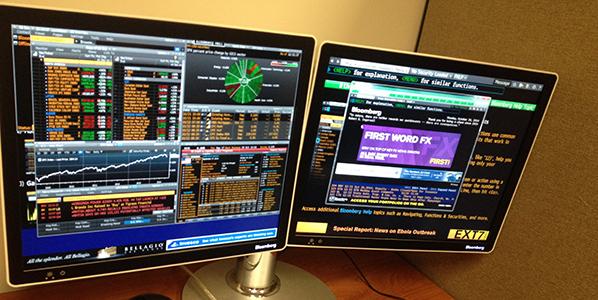
The Bloomberg Terminal is an expensive system that major banks use to get raw data and financial information. The Terminal is out of reach to most ordinary people, but can we create an open-source and open-access alternative Bloomberg to collect, distribute and visualise critical data on high finance? Let’s try!
Saturday 10.30 – 11.30: Brett Scott provides a recap of the first lab*
Open to all, an excellent introduction to the weekend activities.
Saturday 11.30 – 18:00 & Sunday 11:00 – 13:00: Discussions, guided group research, exercises and hands-on activities to familiarise yourself with finance and to build an ‘activist Bloomberg terminal’.
+ Read more about the first lab ‘Building the Activist Bloomberg to demystify High Finance’
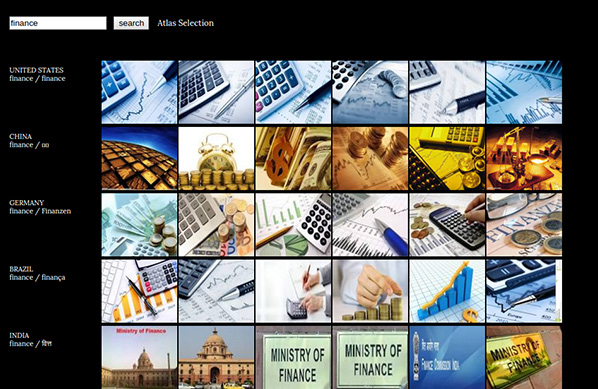
What do we find when we search our minds (or the web) for images of money and finance?
And does it matter if we don’t like what we find? We think it does. We assert that money is an emotional, irrational and mysterious medium of networked trust and that the more we can reclaim its images and associations for communal play and circulation the more likely we are to shape it to our interests. That’s why we are building a new mood board for future money.
Saturday 12:00 – 13:00: introduction to the image of money
Talk – Brett Scott (LSFA) introduces the topic with a broad sweep history of money from the primordial swamp to High Frequency Trading
Saturday 13.00 – 17.00: Money mood board workshop
Participants are invited to drop in and take a series of challenges to make, remix and reappropriate photographs – going out onto the streets, searching, interpreting and tagging photographs from some great digital archives and the World Wide Web to create a new image bank for money past, present and future – online and on the walls of The Photographers Gallery
Sunday 11.00 – 13.00: Money mood board workshop continued
Sunday 14.00 – 17.00: Sunday Workshop – Money Masks
Furtherfield take over our regular drop-in workshop for all ages. Visitors are invited to imagine the main players in the future of money and finance: mysterious, glamorous, fierce or ethereal, human or machine. Download, print, collage and assemble masks for a carnival of characters in the future of money.
Reclaim money for the good of us all, and have fun doing it, join us for a weekend.
All events are included with exhibition day pass charge, no booking necessary
A discussion event with presentation and film screening. (free lunch)
Interruptions is a new research project by The Bad Vibes Club commissioned by Field Broadcast. Interruptions will present a new history of interruption as an artistic practice, focusing on British artists’ film, video, moving image and digital art.
Join The Bad Vibes Club (Sam Mercer and Matthew de Kersaint Giraudeau) for an afternoon of presentations, discussions and films about interruption and its relationship to art practice and contemporary culture.
Sam and Matt will begin by presenting the I nterruptions project. This will be followed by an open discussion of interruptions in response to the project, with a vegetarian lunch provided by The Bad Vibes Club. The afternoon will end with a film screening of some interruptive works.
12 midday Introduction to Interruptions by The Bad Vibes Club
1pm Discussion (with free lunch)
3pm Film screening
The Bad Vibes Club will produce public moments of research throughout the Interruptions project in the form of a continually updated tumblr , videos and multimedia research published at fieldbroadcast.org , and discussions and screening events at Peter Scott Gallery, Lancaster Arts, MK Gallery, Furtherfield and Open School East.
Interruptions will culminate in a new series of broadcasts by The Bad Vibes Club in May 2016 using the Field Broadcast app.
The Bad Vibes Club is a research project into morbid ethics and the productive possibilities of negative states. For Interruptions, the artists Matthew de Kersaint Giraudeau and Sam Mercer, will be working as The Bad Vibes Club.
Field Broadcast is a live broadcast project connecting artists, audiences and obscure locations through the portal of the computer desktop. Field Broadcast has developed through the practice of, and is run by, artists Rebecca Birch and Rob Smith.
Interruptions is supported by Arts Council England, with thanks to Peter Scott Gallery, Lancaster Arts, MK Gallery, Furtherfield, Open School East, Nottingham Trent University, LUX and the British Artists’ Film and Video Study Collection.
LAB #4 in the Art Data Money series
Venue:Furtherfield Commons
BOOKING INFO: This event is for an invited group of participants. If you are interested in attending, please contact Furtherfield telling us about your interest in this area: ruth.catlow [at] furtherfield.org
A day-long workshop, led by independent curators and researchers Dani Admiss and Cecilia Wee, looking at how we are locked-into contemporary conditions that bring migration into being.
This workshop challenges participants to expand and rethink what potential responses to migration could be, creatively and beyond. How can we work with the technologies associated with migration (and their social effects) to inform and enact virtual mobility and cultural activism?
Thinking through ideas of art and social change, the day aims to unpick the abstract forces, the limited means we have to communicate them, and the dependency on automation, simulation, and capture to tell us the ‘truth’, but which escapes the importance of lived experience.
Over the course of a day we will produce a collaborative map that creatively challenges and proposes new ways of thinking about experiences of migration. We will physically engage with technologies associated with migration, this will be followed by discussions about migration using the ‘social technology’ of the World Cafe method. The day will end with a collaborative mapping exercise harvesting ideas and narratives from the day, which will be turned into a mini-publication to be publicly distributed, a record of collectively working together over a day.
As we come closer to COP21 in Paris, and in light of the recent media attention depicting an exodus of asylum seekers, refugees and migrants into Europe, we see that complex flows of power interlink fields of life like security, finance, health, climate and governance in contemporary globalisation, producing barriers to all forms of mobility. We propose that ‘technologies of migration’ instantiate themselves a new type of border, often geographically displaced and abstracted from our physical experiences of mobility. These technologies are subjects of social engineering, residing in websites and interview rooms, as well as more immediately perceivable ‘arrival infrastructures’ of e-border and immigration detention centres. Governments continue to seek ways to measure the political into policy. Expert devices, such as civic integration examinations, speech recognition technology, or European databanks of asylum seekers’ biometric data, map the phenomena of migration and mobility into knowledge practices, incorporating them into risk profiles and evidence-based strategies. For better of worse, the current migration controversy highlights the fundamentally problematic challenges to a humanist relationship to data and information.
‘The Migrant Machine’ is part of a broader research project, Ground Truth: an investigation into changing relations of how we come to see, sense and survey our world. Based on groundtruthing, the calibration process used by scientists and cartographers to anchor the map or model to the data collected from the reality of lived-experience, the project aims to think beyond mapping as a responsive but singular tool of resistance and collaboration and towards being-in-the-world as a continual form of responsibility and entanglement.

DOWNLOAD
PRESS RELEASE (pdf)
‘Agliomania, eating and trading my stinky roses’ by Shu Lea Cheang. Courtesy of the artist and MDC #76 We Grow Money, We Eat Money, We Shit Money.
SEE IMAGES FROM THE PRIVATE VIEW
Featuring Émilie Brout and Maxime Marion, Shu Lea Cheang, Sarah T Gold, Jennifer Lyn Morone, Rhea Myers, The Museum of Contemporary Commodities (MoCC), the London School of Financial Arts and the Robin Hood Cooperative.
Furtherfield launches its Art Data Money programme with The Human Face of Cryptoeconomies, an exhibition featuring artworks that reveal how we might produce, exchange and value things differently in the age of the blockchain.
Appealing to our curiosity, emotion and irrationality, international artists seize emerging technologies, mass behaviours and p2p concepts to create artworks that reveal ideas for a radically transformed artistic, economic and social future.
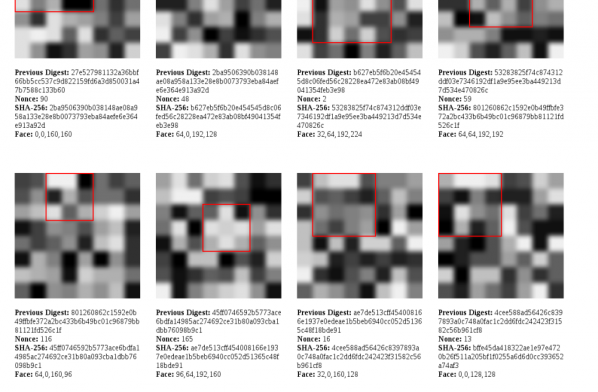
Have you ever looked for faces in the clouds, or in the patterns in the wallpaper? Well, Facecoin is an artwork that is a machine for creating patterns and then finding ‘faces’ in them. It is both an artwork AND a prototype for an altcoin (a Bitcoin alternative).
Facecoin creates patterns by taking the random sets of data used to validate Bitcoin transactions and converting them into grids of 64 grayscale pixels. It then scans each pixel grid, picking out the ones that it recognises by matching its machine-definition of a human face. Facecoin uses the production of “portraits” (albeit by a machine) as a proof-of-aesthetic work. Facecoin is a meditation on how we discern and value art in the age of cryptocurrencies.
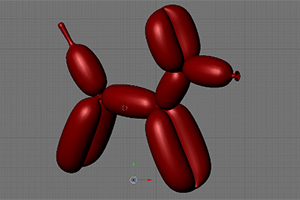
Shareable Readymades are iconic 3D printable artworks for an era of digital copying and sharing.
Duchamp put a urinal in a gallery and called it art, thereby transforming an everyday object and its associated value. Rhea Myers takes three iconic 20th century ‘readymades’ and transforms their value once again. By creating a downloadable, freely licensed 3D model to print and remix, everyone can now have their own Pipe, Balloon Dog and Urinal available on demand. Click here to collect your own special edition version of these iconic artworks.
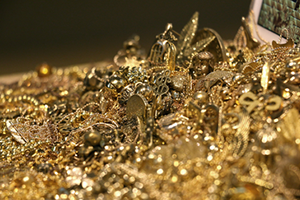
A hoard of golden trinkets to appeal to our inner Midas. An image projection of found GIFs, collected from the internet, creates a gloriously elaborate, decorative browser-based display hosted at www.goldandglitter.net. It prompts reflections on the value of gold in an age where the value of global currencies are underpinned primarily by debt, and where digital currencies are mined through the labour of algorithms.
Also by Émilie Brout and Maxime Marion:
Nakamoto (The Proof) – a video documenting the artists’ attempt to produce a fake passport of the mysterious creator of Bitcoin, Satoshi Nakamoto.
Untitled SAS – a registered company with 10,000 shares that is also a work of art. SAS is the French equivalent of Corp or LTD. http://www.untitledsas.com/en
Jennifer Lyn Morone™ Inc reclaims ownership of personal data by turning her entire being into a corporation.

The Museum of Contemporary Commodities by Paula Crutchlow and Dr Ian Cook treats everyday purchases as if they were our future heritage. The project is being developed with local groups in Finsbury Park in partnership with Furtherfield.
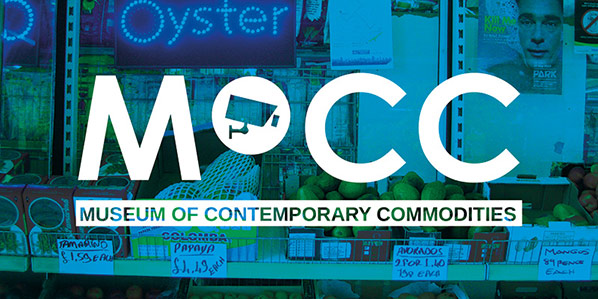
The Alternet by Sarah T Gold conceives of a way for us to determine with whom, and on what terms, we share our data.
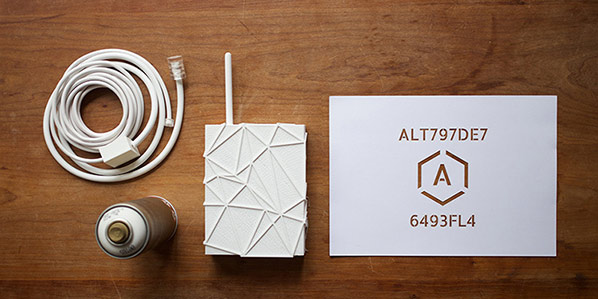
Shu Lea Cheang anticipates a future world where garlic is the new social currency.
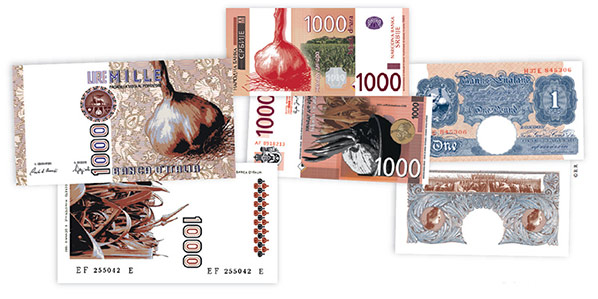
Also, as part of Art Data Money, join us for data and finance labs at Furtherfield Commons.
LAB #1
Share your Values with the Museum of Contemporary Commodities
Saturday 17 October, 10:30am-4:30pm
A popular, data walkshop and lego animation event around data, trade, place and values in daily life.
Free – Limited places, booking essential
LAB #2
Breaking the Taboo on Money and Financial Markets with Dan Hassan (Robin Hood Coop)
Saturday 14 & Sunday 15 November, 11:00-5:00pmA weekend of talks, exercises and hands-on activities focusing on the political/social relevance of Bitcoin, blockchains, and finance. All participants will be given some Bitcoin.
£10 per day or £15 for the weekend – Limited places, booking essential
LAB #3
Building the Activist Bloomberg to Demystify High Finance with Brett Scott and The London School of Financial Arts
Saturday 21 & Sunday 22 November, 11:00-5:00pm
A weekend of talks, exercises and hands on activities to familiarise yourself with finance and to build an ‘activist Bloomberg terminal’.
£10 per day or £15 for the weekend – Limited places, booking essential
LAB #4
Ground Truth with Dani Admiss and Cecilia Wee
Saturday 28 November, 11-5pm
Exploring contemporary ideas of digital agency and authorship in post-digital society.
LAB #5
DAOWO – DAO it With Others
November/February
DAOWO – DAO it With Otherscombines the innovations of Distributed Autonomous Organisations (DAO) with Furtherfield’s DIWO campaign for emancipatory networked art practices to build a commons for arts in the network age.
Émilie Brout & Maxime Marion (FR) are primarily concerned with issues related to new media, the new forms that they allow and the consequences they entail on our perception and behaviour.Their work has in particular received support from the François Schneider Foundation, FRAC – Collection Aquitaine, CNC/DICRéAM and SCAM. They have been exhibited in France and Europe, in places such as the Centquatre in Paris, the Vasarely Foundation in Aix-en-Provence, the Solo Project Art Fair in Basel or the Centre pour l’Image Contemporaine in Geneva, and are represented by the 22,48 m² gallery in Paris.
Shu Lea Cheang (TW/FR) is a multimedia artist who constructs networked installations, social interfaces and film scenarios for public participation. BRANDON, a project exploring issues of gender fusion and techno-body, was an early web-based artwork commissioned by the Guggenheim Museum (NY) in 1998.
Dr Ian Cook (UK) is a cultural geographer of trade, researching the ways in which artists, filmmakers, activists and others try to encourage consumers to appreciate the work undertaken (and hardships often experienced) by the people who make the things we buy.
Paula Crutchlow (UK) is an artist who uses a mix of score, script, improvisation and structured participation to focus on boundaries between the public and private, issues surrounding the construction of ‘community’, and the politics of place.
Sarah T Gold (UK) is a designer working with emerging technologies, digital infrastructures and civic frameworks. Alternet is Sarah T Gold’s proposal for a civic network which extends from a desire to imagine, build and test future web infrastructure and digital tools for a more democratic society.
Dan Hassan (UK) is a computer engineer active in autonomous co-operatives over the last decade; in areas of economics (Robin Hood), housing (Radical Routes), migration (No Borders) and labour (Footprint Workers). He tweets as @dan_mi_sun
Jennifer Lyn Morone (US) founded Jennifer Lyn Morone™Inc in 2014. Since then, her mission is to establish the value of an individual in a data-driven economy and Late Capitalist society, while investigating and exposing issues of privacy, transparency, intellectual property, corporate governance, and the enabling political and legal systems.
Rhea Myers (UK) is an artist, writer and hacker based in Vancouver, Canada. His art comes from remix, hacking, and mass culture traditions, and has involved increasing amounts of computer code over time.
Brett Scott (UK) is campaigner, former broker, and the author of The Heretic’s Guide to Global Finance: Hacking the Future of Money (Pluto Press). He blogs at suitpossum.blogspot.com and tweets as @suitpossum
The Human Face of Cryptoeconomies is part of Art Data Money, Furtherfield’s new programme of art shows, labs and debates that invites people to discover new ways for cryptocurrencies and big data to benefit us all. It responds to the increasing polarisation of wealth and opportunity, aiming to build a set of actions to build resilience and sustain Furtherfield’s communities, platforms and economies.
About Furtherfield
Furtherfield was founded in 1997 by artists Marc Garrett and Ruth Catlow. Since then Furtherfield has created online and physical spaces and places for people to come together to address critical questions of art and technology on their own terms.
Furtherfield Gallery
McKenzie Pavilion
Finsbury Park, London, N4 2NQ
Visiting Information
LAB #2 in the Art Data Money series
A weekend workshop, led by Dan Hassan of the Robin Hood Cooperative, focusing on the political/social relevance of Bitcoin, blockchains, and finance. All participants will be given some Bitcoin.
ADMISSION FEE: £10 for one day or £15 for the weekend*
The weekend workshop will take a historical look at the political / social relevance of Bitcoin (“Breaking the Taboo on Money”) by looking at the history of technical and social inventions the came before it. I’ll then futurecast what this could mean for the future of p2p finance (blockchains, new social architectures and peer owned platforms with a mix of synthetic finance, peer-owned-banks) and place Robin Hood Coop within this future (“Breaking the Taboo of Financial Markets”).
It will include hands on activities on covering topics such as blockchains (actually running them and understanding them) as well as dissecting financial instruments – such as Robin Hood Cooperative has been doing.
Day 1 – Breaking the Taboo on Money (focus on Bitcoin and blockchain):
11.00 Group introductions
11.30 Bitcoin, blockchains, finance – a series of quick 5 minute 101 introductions
11.30 – 13.00 Using Bitcoins whilst expanding our understanding of why this is so groundbreaking
13.00 – 13.30 Lunch
13.30 – 14.00 Recap
14.00 – 17.00 (with tea breaks) tbc
Day 2 – Breaking the Taboo on Financial Markets (focus on Robin Hood’s activities on Wall Street):
11.00 Group introductions
11.30 Bitcoin, blockchains, finance – a series of quick 5 minute one-to-one introductions (+ quick recap from the previous days session).
11.30 – 13.00 Emergent workshop from constellation of interests of those who turn up
13.00 – 13.30 Lunch
13.30 – 14.00 Recap
14.00 – 17.00 (with tea breaks) tbc
Part of Furtherfield’s Art Data Money programme.

– If you can’t afford the entry price, get in touch anyway and we can figure something out.
– All participants will be given some Bitcoin
– The workshop runs across two days. Both days will be complementary, but will also be standalone. there won’t be too much duplication for those who attend both, but you won’t be left behind if you only attend one.
Pre-reading / listening: Listen to as much of this talk by Vinay Gupta as you can.
Robin Hood Asset Management Cooperative is a cooperative owned and run by its members. At the moment we have over 500 members from 15 different countries and together we manage assets of about half a million euros. In the two years we have been active, we have created over 100,000 euros to our members and to our common pool. We disrupt the ordinary flows of money, share the loot, and invest the profits in the production and protection of commons.
More info: http://robinhoodcoop.org/
Dan Hassan (UK) is a computer engineer active in autonomous co-operatives over the last decade; in areas of economics (Robin Hood), housing (Radical Routes), migration (No Borders) and labour (Footprint Workers). He tweets as @dan_mi_sun